RBA Annual Conference – 1990 Saving and Investment Malcolm Edey and Mark Britten-Jones[*]
1. Introduction
Perceptions about Australia's saving performance have changed remarkably during the past decade. In his review of household saving and consumption in the 1970s, Williams (1979) argued that the main outstanding issue was to explain the persistence of household saving rates which appeared historically high. Corden (1979) added that on balance, economists considered those high saving rates a bad thing, contributing to a lack of demand and hence to unemployment. A decade later the concerns are very different. The household saving ratio has been steadily declining and the macroeconomic debate has placed a strong emphasis on the presumed link between insufficient saving and the accumulation of external debt. Policies to boost private savings have been actively canvassed. These concerns represent a major shift from a focus on high saving rates and their consequences in the 1970s, to a corresponding focus on the apparently low saving rates of the late 1980s.
It will be the contention of this paper that, at least in relation to private sector behaviour, both concerns appear to have been unwarranted. The paper argues that for various reasons the household saving ratio gives a misleading impression of the broad trends. Our preferred measure, gross private sector saving adjusted for inflation, has fluctuated in a fairly narrow band around 15 per cent of GDP at least since the early 1960s, and provides no evidence of a trend deterioration in private saving levels. At the same time, gross investment by the private sector has if anything tended to increase as a share of GDP. Concerns about the adequacy of total national savings may still be justified, but these should be focused on performance in the public sector, where rates of saving and investment in the 1980s have been significantly lower than historical averages.
The paper is structured so as to focus initially, in Section 2, on presentation of the main facts about saving and investment, and on issues concerning the measurement of savings. The remaining sections consider possible explanations for various aspects of saving and investment behaviour, and discuss the role of saving-investment imbalances in the determination of the current account. In the final section the main policy issues raised in the paper are drawn together.
2. Trends in Saving and Investment
(a) Household and Private Sector Saving Ratios
Saving is broadly defined as the difference between income and consumption, but this definition leaves open a number of questions, not only about how consumption and income should be measured, but also about the appropriate sectoral boundaries for any study of saving behaviour. In Australia the most commonly discussed measure of saving is probably the household saving ratio, which defines saving as the difference between net household disposable income and consumption. The behaviour of this ratio over the past three decades is shown in Figure 1.[1]
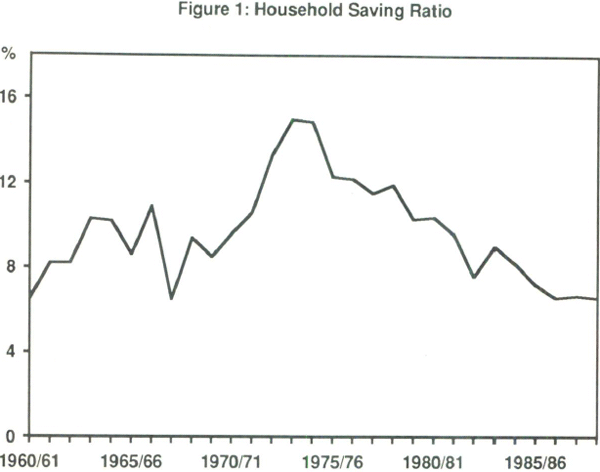
The household saving ratio has averaged about 10 per cent in the period under discussion, but in the late 1980s has been somewhat below this level, coming in at under 7 per cent in 1988/89. More worrying for some commentators has been the consistent downward trend evident over the past 15 years. This feature has some parallels with overseas experience, as has been noted for example by Hayashi (1986, 1989) in his comparative studies of the United States and Japan.
Before any attempt is made to explain the underlying saving behaviour, it is important to examine the extent to which these apparent trends may be the result of poor measurement. There are in fact a number of reasons why the household saving ratio may give an inaccurate picture. First, there is the failure of conventional national accounts to recognise the transfer of income between borrowers and lenders effected by inflation. Anstie, Gray and Pagan (1983) showed that adjusting for this effect substantially reduces the mid-seventies anomaly in measured saving. A second issue, which emerges particularly strongly from international comparisons (for example Dean et al, 1989), is that saving patterns of the private sector as a whole tend to be more stable than those of households; there is a strong tendency for movements in household and business savings to offset one another. Given that the boundary between households and businesses is to some extent arbitrary in any case, this suggests that a narrow focus on the household sector may sometimes be misleading. Other measurement problems concern the estimation of depreciation values used in net saving measures, the treatment of consumer durables, and the potential inclusion of capital gains in income. This list is far from exhaustive; Eisner (1988) provides a detailed critique of the national accounting measures which are used to derive estimates of savings. Some of the adjustments which Eisner advocates would raise almost insurmountable problems of data availability, and this section of the paper focuses on a selection of the measurement issues raised above for which reasonably good data are available to make the necessary adjustments. Specifically, it will examine the issues of inflation adjustment, depreciation calculations, and the treatment of consumer durables. The further issue of the role of capital gains and wealth will be discussed in Section 3.
(i) Private Saving and Inflation
Gross private sector saving (shown in Figure 2) is equal to the sum of household saving and corporate retained earnings, where both are measured before deduction of depreciation. It is apparent from the graph that much of the variation in household saving over the period shown has been offset by compensating changes in business saving, resulting in a considerably more stable picture when the private sector is taken as a whole. The mid-1970s peak in saving remains, but at 19 per cent of income this is only 2 percentage points above the three-decade average. Dean et al (1989) suggest measuring the degree of offset between household and business saving using a simple regression of one variable against the other. Their results using a pooled cross-section and time series sample of OECD countries showed an estimated offset coefficient of 0.8, implying that a dollar rise in business saving is associated with a fall in household saving of about 80 cents. Our estimates using Australian data are very similar.
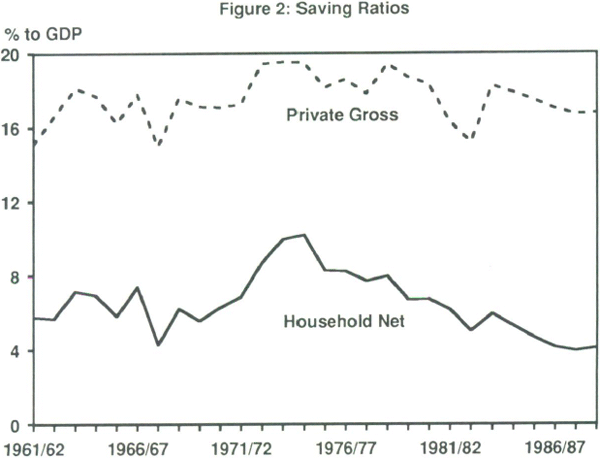
The idea that households adjust their saving to take account of corporate behaviour is sometimes described in terms of households ‘seeing through the corporate veil’, recognising their ownership of corporate earnings irrespective of the extent to which they are distributed as dividends. There are certain similarities between this and the Ricardian equivalence proposition, which essentially asserts that households recognise the net present value of government cash flows as part of their wealth. But there is an important difference which makes the corporate-household behavioural link a much more plausible one than the corresponding link between households and governments. Corporate wealth has a market value which can be more or less continually observed by shareholders. Provided sharemarkets do not suffer from ‘dividend illusion’ (i.e. valuing companies inconsistently before and after dividend distributions), shareholder wealth will be unaffected by the way companies divide their profits between dividends and retained earnings. It seems reasonable to suppose that consumption by shareholders would be similarly unaffected.[2] To this point it might be added that the dividing line between the household and corporate sectors is in any case to some extent arbitrary. The corporate sector includes many entities like family businesses and private investment vehicles which exist as accounting devices for the purpose of gaining corporate tax treatment for households; and the household sector is generally defined to include unincorporated enterprises which for many purposes could be expected to behave like companies. For these reasons we conclude that household and corporate savings should not be studied as separate aggregates.
The conclusion that private saving in Australia has been relatively stable becomes stronger when adjustments are made for the redistributive impact of inflation. In the national accounts all interest flows are measured on a purely nominal basis and do not make any allowances for the effect of inflation in transferring income from lenders to borrowers. Generally this means that private sector income (and hence saving) is overstated because the private sector is a large net holder of government liabilities. Saving rates adjusted for the inflation transfer between public and private sectors are shown in Figure 3.[3]
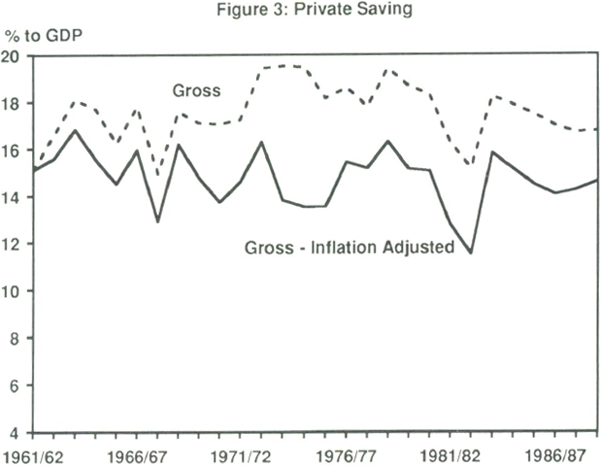
Since the private sector has been a substantial net holder of government liabilities throughout the three decades, the main effect of the inflation adjustment, shown in Figure 3, is to reduce private income, and hence saving, throughout the period. Public sector income is correspondingly raised. Not surprisingly, the downward adjustment to private saving is largest in the mid 1970s when domestic inflation rates were highest. Inflation adjustment removes the peak that occurred in 1974/75, and leaves a measure of private saving which has been remarkably stable over three decades.
Using the revised measure, the largest deviation from average behaviour occurred in 1982/83, when the adjusted saving ratio fell to a little over 11 per cent of GDP. This coincided with the most severe recession of the post-war period, and it will be argued in Section 3 that saving behaviour at that time can be well explained by models of consumption smoothing which predict that saving rates vary inversely with incomes. After 1982/83, adjusted saving rates quickly recovered to levels around their long run average.
(ii) Gross and Net Saving
Net saving rates are calculated by deducting from income the estimated depreciation of the capital stock. In principle this results in a savings measure which is more in accord with the theoretical notion of savings representing net increments to wealth. Unfortunately however, depreciation cannot be directly measured, and must be derived from gross investment data using a variety of assumptions about the length of asset lives. Using depreciation estimates provided in the national accounts, in conjunction with the adjusted gross private saving figures derived above, an estimate of inflation-adjusted net saving can be calculated (Figure 4). In contrast to the impression given by gross saving data, it would appear that net private saving rates in the 1980s have been considerably below levels of the previous two decades. However, in what follows it is argued that this conclusion is extremely sensitive to assumptions and is inconsistent with other information relevant to the estimation of aggregate depreciation.
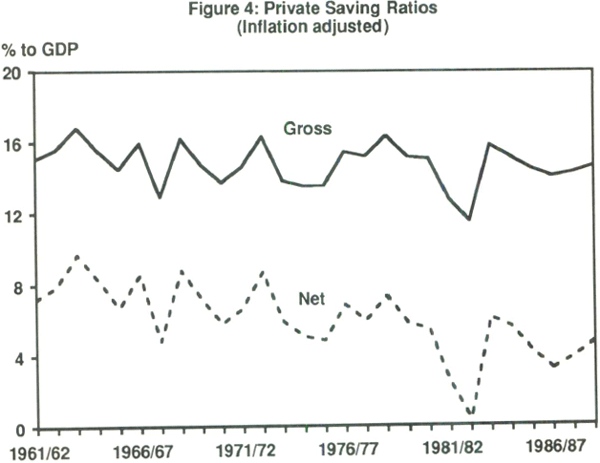
The sensitivity of depreciation estimates to changes in basic assumptions has recently been demonstrated in the case of the manufacturing sector by Lattimore (1989). Official figures for capital stock and depreciation are calculated using a complicated formula which distinguishes between ‘retirement’ and depreciation of capital (see Walters and Dippelsman (1985)). Since neither concept is directly observable, it seems sensible for the purposes of this paper to adopt the more transparent approach of assuming constant proportional depreciation. Lattimore shows that this closely approximates the ABS method for the manufacturing sector, and Figure 5 confirms this in the aggregate case using an assumed constant depreciation rate of 6.5 per cent. The point to be made here is that the existence or otherwise of an upward trend in depreciation as a share of income depends basically on the assumed depreciation rate. At 6.5 per cent, both depreciation and the net capital stock show an upward trend relative to income; a lower depreciation rate exacerbates this trend because capital is allowed to accumulate more quickly in the earlier years, while a higher depreciation rate of about 10 per cent is sufficient to remove it (Figures 6 and 7).
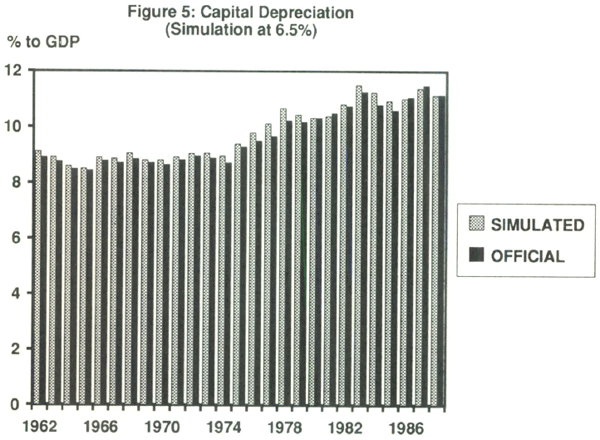
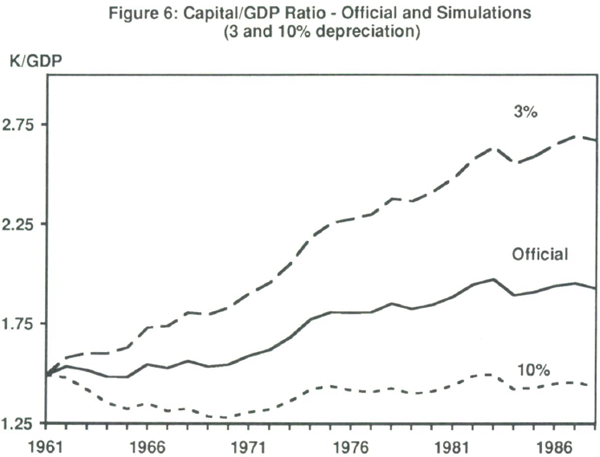
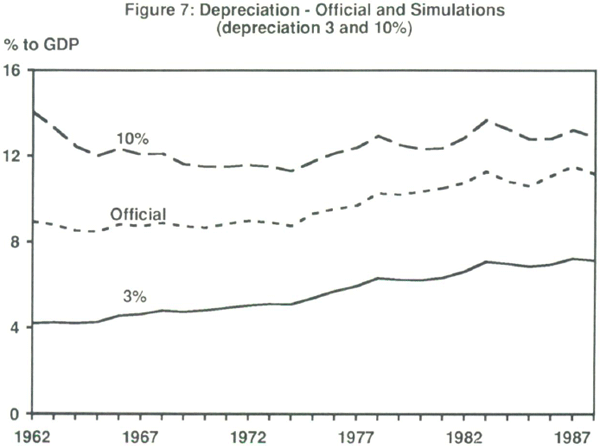
An argument which supports use of the higher depreciation rate is that the derived capital stock valuations need to be consistent with other information about returns to capital. Roughly speaking, corporate gross profits represent the value of the capital stock times the rate of return on capital, so that given estimates for any two of these concepts, the third can be inferred. As is evident from Figure 8, corporate profits have not shown any long-run tendency to increase as a proportion of national income, so the upward trend in capital stock valuation would therefore imply a strong downward trend in the rate of return on capital in the 1970s and 1980s. Estimates of the rate of return calculated by Dews (1988) in fact show the reverse. In resolving this inconsistency we would argue that the official capital stock data is probably the least reliable of the three pieces of information, thus providing some justification for preferring a capital stock measure in which the upward trend is removed.
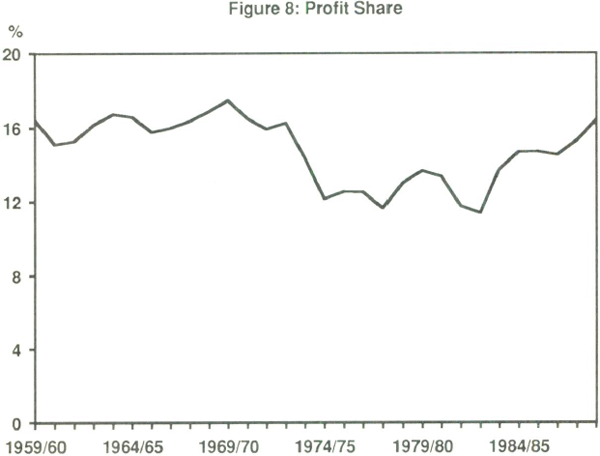
These considerations do not of course justify a claim that 10 per cent (or some other figure) represents the ‘correct’ rate of depreciation for the purposes of calculating net saving.[4] They do however cast doubt on official figures which imply strong rises in the ratios of depreciation and the capital stock to national income in the 1970s and 1980s. To avoid these problems we are advocating a focus on gross rather than net saving rates, and a corresponding focus on gross investment rather than investment net of depreciation. (These issues do not affect any analysis of saving-investment imbalances, measures of which are unaffected by adjustments for depreciation.)
(iii) Consumer Durables
Many of the components of household spending have to some extent the characteristics of investment goods which are not fully consumed when purchased. It is often argued that such expenditures should be recorded in consumption as their benefits accrue, in much the same way as is done with housing expenditure, rather than being recorded at the time of purchase. While undoubtedly valid in principle, this argument can be taken to almost any lengths, and sometimes is. An extreme example would be Shiller's (1982) suggestion that expenditures on holidays be counted as an investment which yields a subsequent flow of services in the form of happy memories.
Similarly, Heijdra and James (1989) have argued that all expenditures have some element of durability. From a practical point of view the main issue would seem to rest on the rate of depreciation of such expenditures: those which depreciate relatively quickly are likely to be well approximated at an aggregate level by the conventional method based on recording at the time of purchase; for longer-lived goods, such as motor vehicles, this might not be a good approximation.
To give an idea of the potential size of these effects, Figure 9 shows an alternative measure of household saving obtained by excluding expenditure on durables from consumption, and adding back an imputed service flow from the stock of durables outstanding. As might be expected, the main effect of this adjustment is to change the timing rather than the level of consumption, and it would appear that the adjustment does not have an important quantitative effect on the general trends. This is not to deny that adjustments for consumer durables may be important in certain econometric studies (for example, McKibbin and Richards (1988) and various recent overseas studies) where the timing of consumption expenditure is of fundamental importance.
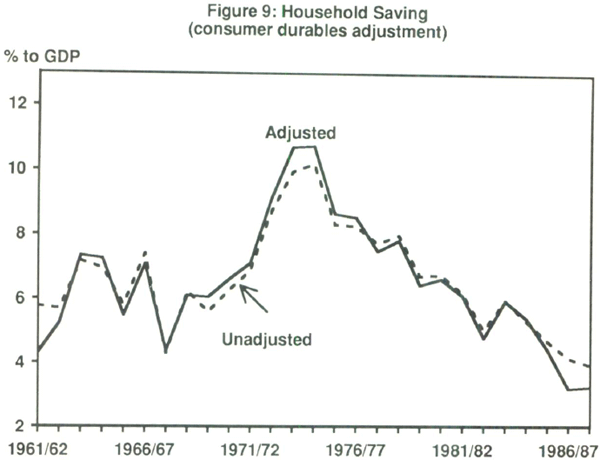
(b) Private Investment
Measured on a gross basis, investment expenditures are not subject to the same conceptual difficulties associated with the measurement of saving and, with the exception of any problems in the reliability of the basic sources (an issue discussed further in Section 2(g)), measurement errors can be safely ignored. Figure 10 shows
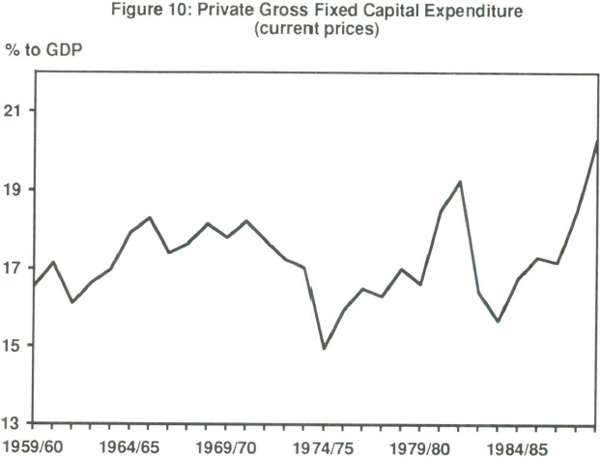
Australia's gross private investment ratio over the past three decades. The investment ratio has tended to show a stronger cyclical behaviour than saving, with total private investment varying between about 15 and 20 per cent of nominal GDP over the period.
Private investment is usually disaggregated into three categories according to asset type: namely, dwellings, non-dwelling construction and equipment (Figure 11). The dwellings component has been relatively stable at around 5 per cent of GDP throughout the period, although a cyclical behaviour is clearly evident especially in the late 1970s and in the 1980s. The 1970s were characterised by generally low levels of business investment (that is, excluding the dwellings component), and since the gradual recovery from the mid 1970s trough there can be said to have been two investment boom periods. The first, around 1980/81, was associated with the mineral resources boom, but the strong investment growth of this period was not confined to the mining industries; to a lesser extent the manufacturing and other sectors also showed expanded levels of investment. The boom was short-lived however, and was followed by a sharp contraction in investment levels. This followed a similar contraction in company profits which, as will be discussed in Section 4, appears to be an important explanatory variable for investment behaviour in Australia.
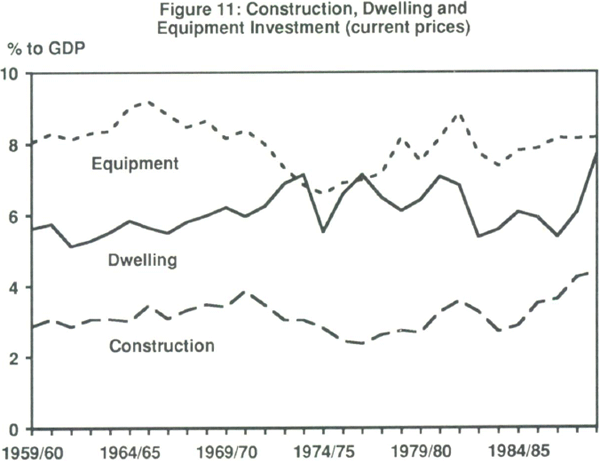
The second period of strong investment growth occurred in the latter part of the 1980s, mainly between 1986 and 1988. The strongest growth rates were in non-dwelling construction activity, which in the three years to 1987/88 grew by over 50 per cent in real terms. On an industry basis, much of this is recorded as belonging to the finance sector, and represents growth in office developments; investment in offices was both the largest and the fastest growing component of construction activity during this period. Plant and equipment investment was much more stable than construction spending, at least when viewed in value terms (as in Figure 11). This however masks a very strong growth at constant prices, especially in 1988 (see Figure 12); plant and equipment expenditure has a high import cost component and the prices of imported capital goods were falling significantly at that time.[5] In constant price terms, plant and equipment investment grew by over 25 per cent in the two years to 1988/89. Whether it is appropriate to look at constant or current price data of course depends largely upon the uses to which the information is being put. Constant price investment data is probably the most relevant in assessing additions to productive capacity; however in comparing saving and investment ratios and assessing the adequacy of savings to finance investment expenditures, it is the nominal values that are important.
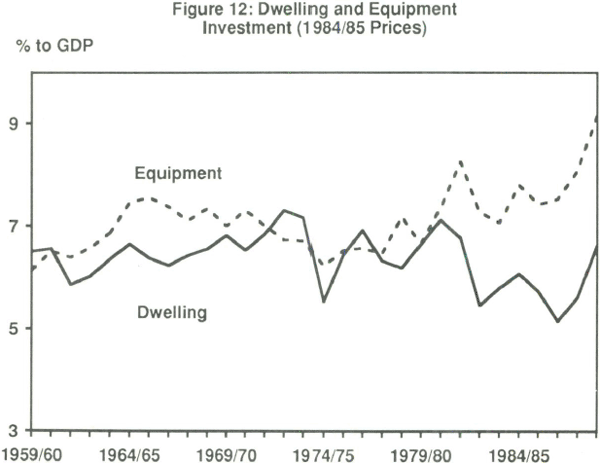
(c) The Allocation of Private Savings
Financial flow data show that the allocation of private savings between asset components has changed markedly in the second half of the 1980s. Estimates of the main components are shown in Tables 1 and 2.
| Gross Saving | Dwellings |
Other Capital | Bank Deposits | Govt Securities | Life & Super | Minus Advances | Other |
|
|---|---|---|---|---|---|---|---|---|
| 1979/80 | 11.2 | 5.3 | 4.5 | 3.2 | 0.9 | 2.3 | (5.3) | 0.3 |
| 1980/81 | 11.4 | 5.9 | 4.7 | 3.9 | 1.1 | 2.3 | (6.1) | −0.4 |
| 1981/82 | 11.2 | 5.7 | 4.5 | 2.9 | 1.1 | 2.4 | (6.3) | 0.8 |
| 1982/83 | 10.4 | 4.5 | 3.1 | 3.8 | 1.9 | 2.4 | (5.0) | −0.2 |
| 1983/84 | 11.1 | 4.5 | 4.2 | 3.6 | 2.4 | 2.8 | (6.0) | −0.4 |
| 1984/85 | 10.6 | 4.9 | 4.2 | 4.3 | 0.0 | 3.0 | (6.1) | 0.4 |
| 1985/86 | 10.1 | 4.8 | 4.0 | 3.0 | 0.8 | 3.7 | (5.6) | −0.7 |
| 1986/87 | 9.8 | 4.2 | 3.9 | 3.9 | 0.7 | 5.2 | (5.0) | −3.0 |
| 1987/88 | 9.7 | 4.4 | 4.6 | 2.8 | −1.4 | 6.5 | (6.2) | −0.8 |
| 1988/89 | 9.3 | 5.6 | 5.3 | |||||
|
Notes: ‘Other’ includes unidentified flows. Source: Reserve Bank of Australia, Financial Flow Estimates, November 1989. |
||||||||
| Gross Saving |
Corporate Investment |
Deposits |
Assets Abroad |
Minus Bank Advances |
Minus Other Net Borrowing |
Unidentified |
|
|---|---|---|---|---|---|---|---|
| 1979/80 | 5.5 | 6.7 | 0.7 | 0.5 | (0.6) | (2.8) | 1.1 |
| 1980/81 | 4.8 | 7.7 | 0.4 | 0.2 | (0.3) | (4.9) | 1.7 |
| 1981/82 | 3.8 | 8.6 | 0.4 | 0.4 | (0.6) | (5.2) | 0.1 |
| 1982/83 | 3.5 | 6.3 | 0.4 | 0.6 | (0.1) | (3.7) | −0.1 |
| 1983/84 | 5.5 | 6.2 | 0.2 | 0.6 | (0.2) | (1.9) | 0.7 |
| 1984/85 | 6.6 | 7.0 | 1.7 | 1.2 | (1.8) | (3.0) | 1.5 |
| 1985/86 | 6.4 | 8.4 | 1.2 | 1.0 | (1.6) | (5.6) | 3.0 |
| 1986/87 | 6.3 | 7.7 | 0.6 | 1.8 | (1.8) | (5.9) | 4.0 |
| 1987/88 | 6.4 | 8.5 | 0.6 | 2.2 | (1.7) | (6.3) | 3.0 |
| 1988/89 | 6.7 | 9.2 | |||||
|
Note: Columns 2 to 7 add to Column 1. Source: As above. |
|||||||
In the household sector (which includes unincorporated enterprises), aggregate saving has traditionally been allocated mainly to physical capital formation, in the form of the housing stock and investment by unincorporated enterprises. Other financial flows within the household sector have tended in a rough sense to offset one another,[6] the gross flows being much larger than the household sector's net borrowing or lending position; both the incurrence of liabilities (mainly to financial institutions) and the acquisition of financial assets have grown more or less in line with the household sector's physical capital formation. The importance of house purchases in the household sector's aggregate saving is confirmed by estimates of the household sector's stock of wealth; Piggott (1986) calculated that in 1985 the value of houses accounted for about 55 per cent of the household sector's aggregate wealth.
In the period since about 1984/85, there have been two major changes in the financial flow behaviour of households. First, the household sector has gradually moved from a net lending to a net borrowing position, becoming a net borrower for the first time in 1988/89. This was mainly associated with a gradual reduction in the household sector's contribution to private saving, although 1988/89 was also a year of unusually strong household capital formation. The second major change in behaviour in the household sector has been the massive growth in saving through superannuation funds in recent years. By 1987/88 (the latest year for which figures are available) the household sector's saving through superannuation funds had risen to over 6 per cent of GDP, compared with a level of around 2 per cent which was typical at the beginning of the decade. The 1987/88 figure actually represented more than 100 per cent of net household saving in that year. The growth in this component of household assets reflects two major influences: the favourable tax treatment given to superannuation relative to other forms of financial assets, and the move to award-based superannuation schemes which after 1986 greatly expanded the number of people covered. Section 3 will discuss these issues in more detail and consider the impact of various tax incentives on savings in aggregate, but for the present it is useful to point out that the recent superannuation growth has not coincided with any major shift in the aggregate level of households' gross savings. Offsetting changes have occurred in the rate of acquisition of other financial assets including bank deposits, government securities, and shares. A substantial increase in the household sector's net unidentified flows (possibly representing other unidentified reductions in asset holdings) has also contributed to this.
The corporate sector in Australia is typically a net borrower in flow terms, its gross capital formation each year exceeding gross retained earnings. The financing requirement of the corporate sector, defined as the difference between gross saving and gross investment, has varied between zero and 5 per cent of GDP in the 1980s, and has thus been much more volatile than that of the household sector. In the early 1980s the typical pattern was for the corporate sector to meet its financing requirement by incurring liabilities while doing very little on the financial asset side. From 1984/85 onward however, the gross flows on both sides of the aggregate balance sheet began to increase at a much faster rate, coinciding with removal of exchange controls and other deregulatory initiatives in the financial sector. The financial flow estimates show the corporate sector borrowing substantially more than its financing requirements during this period, with at least part of the proceeds being used to finance the accumulation of assets abroad.[7] Also significant is the increased use of ‘other financial instruments’, including securitised borrowings by companies, as a means of raising funds in addition to conventional loans.
(d) Public Sector Saving and Investment
While private saving rates have arguably been very stable during the past three decades, public sector saving fell considerably after the mid 1970s. Although this trend was reversed in the second half of the decade, rates of public saving remain substantially lower than the levels which were typical in the 1960s and early 1970s (Figure 13). As a result, the rate of gross national saving (the sum of private and public saving) was about 5 percentage points lower in the 1980s than the average for the 1960s, the difference being almost entirely accounted for by the public sector. This has coincided with a decline (though to a lesser extent) in public sector capital formation.
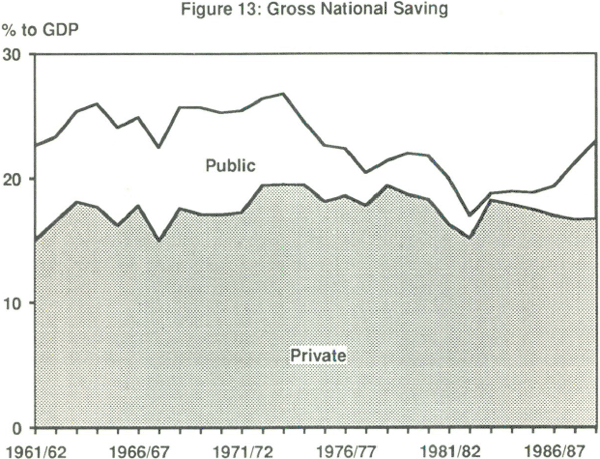
Public sector saving and investment are linked by the following identity:
Public borrowing = Public investment − Public saving.
Public sector gross saving is thus equal to capital formation by the public sector minus that part which is financed by net public borrowing. The relationship is illustrated in Figure 14.[8]
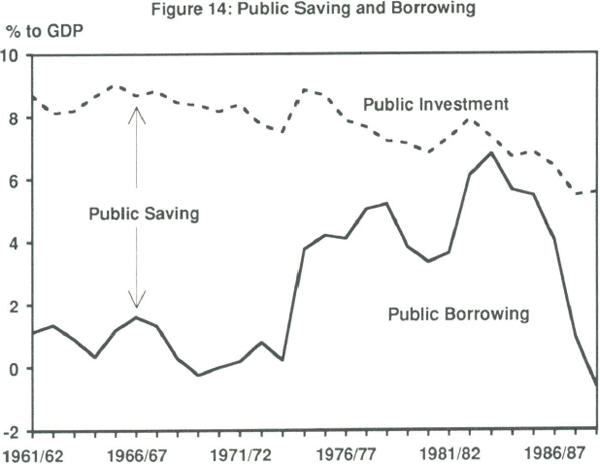
In the 1960s public sector saving was fairly stable at around 8 per cent of GDP which, with investment at around 10 per cent, left a small borrowing requirement of 1 to 2 per cent of GDP. The first major shift in this behaviour occurred in the mid 1970s when public saving contracted markedly, primarily due to a jump in consumption expenditure which was not matched by higher revenues; between 1973/74 and 1975/76, public sector consumption jumped by about 3 per cent of GDP, and there was a similar increase in the PSBR. The PSBR jumped again in the 1982/83 recession period, reaching a peak ratio to GDP of 7 per cent. The increase in this case was mainly associated with revenue shortfalls and increased transfer payments. Nevile (1989) argues that most of this was cyclical in nature, and presents estimates showing that the cyclically adjusted fiscal position was largely unchanged during this period.
However the subsequent period, from 1983/84 to the present, represents a distinctive phase of fiscal policy in which reduced public sector deficits became an important objective. Between 1983/84 and 1988/89, the estimated public sector position was moved in the direction of surplus by about 8½ per cent of GDP. On Nevile's estimates, only about 2 percentage points of this could be attributed to the economic cycle. In an accounting sense, the 8½ per cent change can be split between expenditure reductions (5½ percentage points) and revenue increases (3 percentage points).
On the expenditure side, two further points are worth noting. First, when disaggregated by level of government the largest reductions in expenditure on goods and services were made at State and Local level. Measured on a national accounts basis, State and Local government expenditure on goods and services fell by 3 per cent of GDP between 1983/84 and 1988/89. By contrast, Commonwealth spending reductions were concentrated largely in transfer payments to individuals and to the States. The second point to note is the relative decline in public sector investment expenditure, which has born the brunt of expenditure restraint at an aggregate level.
This has not yet become a major issue in economic debate, but the reduction is substantial, and presumably if sustained will have a cumulatively negative effect on the public sector capital stock. Recent empirical work by Aschauer (1989a, 1989b) and Barro (1989) has suggested that levels of public sector investment may have an important effect on medium to long term productivity growth through the provision of infrastructure which cannot be privately provided.
(e) Saving, Investment and the Current Account
Saving and investment are linked together by the well known identity which states that the current account deficit is equal to the excess of gross national investment over national saving. It will be useful at this point to tie together information on the component parts of this identity.
To begin, Figure 15 shows Australia's gross investment levels during the past three decades, divided into public and private components for comparison with Figure 13 on savings. On the savings side, the relatively stable behaviour of the private sector component has already been noted. Total saving levels have however fallen quite substantially in the second half of the period shown, due to a virtual collapse in the public sector contribution. From a level around 25 per cent of GDP prior to the mid 1970s, national saving levels have fallen to an average of less than 20 per cent, although a partial recovery is evident in the most recent years. National investment (Figure 15) has been more stable than saving. Most of the cyclical variation in investment is driven by the private sector component, but perhaps more significant has been the longer-term trend for public sector investment to fall relative to GDP, while private investment was rising. The two trends have roughly offset one another, with only a slight fall in aggregate investment evident over the period as a whole. Almost without exception in the three decades, gross investment levels have been higher than savings, implying that the current account was in deficit (Figure 16).
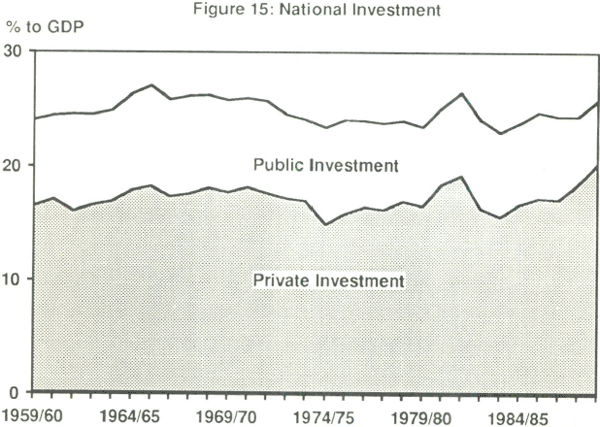
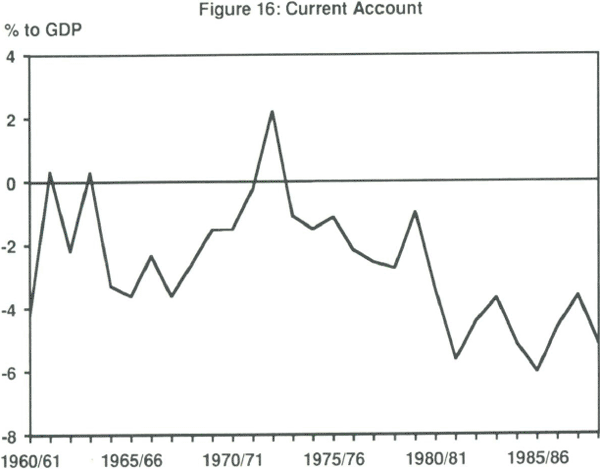
From year to year the current account deficits and savings-investment imbalances do not exactly line up, due to fluctuations in the statistical discrepancy (the significance of which will be discussed in Section 2(g). Over time however the broad trends are fairly clear. Abstracting from cyclical movements, total investment has been more or less steady as a ratio to GDP, while saving levels fell away in the late 1970s and stayed low for most of the subsequent decade. The fall-off in saving, by around 4 or 5 per cent of GDP, roughly matches the increase in current account deficits in the 1980s, although in the most recent years the deficit has risen relative to the identified savings-investment imbalance, representing a trend increase in the statistical discrepancy.
Further details on the sectoral balances are provided in Table 3, expressed on a 5-year average basis to emphasise the broad trends. On this basis it is clear that the discrepancy has not been a factor in the longer-term widening of the current account deficit; the trend contribution of changes in the discrepancy was actually negative. The current account deterioration between the 1970–74 and the 1985–89 periods can be attributed in an accounting sense mainly to the deterioration in the public sector's net financing requirement. When viewed on an annual basis, however (Table 4), this picture breaks down somewhat in recent years. Between 1984/85 and 1988/89 the current account was almost unchanged as a ratio to GDP, while the public sector's financing requirement fell by about 6 per cent of GDP. This reduction was absorbed partly by the discrepancy (1½ per cent) but mainly by an increase in the private sector's financing requirement (mainly through higher investment).
| 1965–69 | 1970–74 | 1975–79 | 1980–84 | 1985–89 | |
|---|---|---|---|---|---|
| PUBLIC | |||||
| Public saving (unadjusted) | 7.79 | 7.84 | 3.60 | 2.56 | 3.10 |
| Inflation gain | 1.83 | 3.42 | 3.88 | 3.27 | 2.65 |
| Public saving (inflation adjusted) | 9.61 | 11.26 | 7.48 | 5.82 | 5.75 |
| Public investment | (8.45) | (7.64) | (7.74) | (7.18) | (6.65) |
| Public financing requirement (inflation adjusted) |
−1.16 |
−3.62 |
0.26 |
1.36 |
0.90 |
| PRIVATE | |||||
| Private saving (unadjusted) | 16.84 | 18.07 | 18.68 | 17.35 | 17.15 |
| Inflation loss | (1.83) | (3.42) | (3.88) | (3.27) | (2.65) |
| Private saving (inflation adjusted) | 15.02 | 14.65 | 14.80 | 14.06 | 14.50 |
| Private investment | (19.39) | (18.45) | (16.91) | (17.56) | (18.32) |
| Private financing requirement (inflation adjusted) |
4.37 |
3.80 |
2.11 |
3.50 |
3.82 |
| Statistical discrepancy | −0.12 | 0.26 | −0.35 | −1.20 | 0.20 |
| Current Account Deficit | 3.09 | 0.44 | 2.02 | 3.65 | 4.92 |
| 1983–84 | 1984–85 | 1985–86 | 1986–87 | 1987–88 | 1988–89 | |
|---|---|---|---|---|---|---|
| PUBLIC | ||||||
| Public saving (unadjusted) | 0.53 | 1.05 | 1.38 | 2.36 | 4.52 | 6.21 |
| Inflation gain | 2.41 | 2.73 | 2.97 | 2.93 | 2.44 | 2.15 |
| Public saving (inflation adjusted) |
2.94 |
3.78 |
4.36 |
5.29 |
6.96 |
8.36 |
| Public investment | (7.37) | (7.05) | (7.50) | (7.26) | (5.91) | (5.53) |
| Public financing requirement (inflation adjusted) |
4.43 |
3.27 |
3.14 |
1.97 |
−1.05 |
−2.83 |
| PRIVATE | ||||||
| Private saving (unadjusted) | 18.22 | 17.87 | 17.46 | 16.98 | 16.69 | 16.76 |
| Inflation loss | (2.41) | (2.73) | (2.97) | (2.93) | (2.44) | (2.15) |
| Private saving (inflation adjusted) |
15.81 |
15.14 |
14.48 |
14.05 |
14.26 |
14.61 |
| Private investment | 16.39 | 17.27 | 17.92 | 16.63 | 18.37 | 21.43 |
| Private financing requirement (inflation adjusted) |
0.58 |
2.13 |
3.44 |
2.58 |
4.11 |
6.82 |
| Statistical discrepancy | −1.31 | −0.26 | −0.54 | 0.07 | 0.57 | 1.16 |
| Current Account Deficit | 3.70 | 5.15 | 6.04 | 4.62 | 3.63 | 5.14 |
One of the lessons of this kind of exercise is that a study of the broad saving and investment aggregates alone is unlikely to yield a satisfactory explanation for short-term movements in the current account. Measurement errors, in the form of the statistical discrepancy, may be relatively small when compared with aggregate saving or investment, but they are large when compared with the saving-investment gap. This would make it difficult to sustain strong conclusions about the behaviour of the current account when they are based on study of the saving and investment aggregates alone.
(f) International Comparisons
International comparisons are often used as a benchmark in examining the adequacy of national saving and investment levels. These comparisons are best made on a gross basis because, as Hayashi (1986) has argued, methods of calculating depreciation can vary markedly across countries and can result in misleading inferences. The main points to emerge from the comparative data (Tables 5 and 6) are that Australia's saving rates have generally been close to the OECD average, while investment levels have tended to be higher. Japan is a consistent outlier in these comparisons, showing much higher rates of both saving and investment than the OECD averages.
| 1960s | 1970s | 1980s | ||||
|---|---|---|---|---|---|---|
| Private | Total | Private | Total | Private | Total | |
| United States | 17.7 | 19.6 | 19.2 | 19.5 | 18.7 | 16.3 |
| Japan | 28.7 | 35.0 | 29.9 | 34.4 | 26.8 | 31.1 |
| Germany | 21.1 | 27.3 | 20.2 | 23.7 | 20.0 | 21.8 |
| France | n.a. | 26.3 | 22.0 | 25.4 | 18.8 | 19.6 |
| United Kingdom | 13.2 | 18.7 | 16.7 | 18.1 | 18.4 | 17.5 |
| Italy | 19.7 | 21.0 | 22.9 | 19.2 | 21.7 | 15.6 |
| Canada | 18.1 | 21.8 | 20.7 | 23.1 | 22.5 | 20.3 |
| Australia | 16.8 | 24.8 | 21.3 | 23.7 | 17.4 | 19.9 |
| Source: Dean et al. (1989). Figures for 1980s are averages to 1987. | ||||||
| 1960s | 1970s | 1980s | ||||
|---|---|---|---|---|---|---|
| Private | Total | Private | Total | Private | Total | |
| United States | 16.1 | 18.8 | 17.9 | 19.3 | 16.5 | 18.1 |
| Japan | 30.7 | 35.1 | 28.2 | 33.8 | 23.7 | 29.0 |
| Germany | 22.7 | 26.6 | 19.5 | 23.0 | 17.6 | 20.0 |
| France | n.a. | 25.4 | 21.8 | 25.2 | 17.0 | 20.1 |
| United Kingdom | 14.7 | 19.0 | 15.7 | 19.6 | 14.5 | 16.6 |
| Italy | 16.8 | 19.5 | 16.6 | 19.4 | 13.2 | 16.7 |
| Canada | 19.9 | 24.0 | 21.3 | 24.7 | 18.9 | 21.6 |
| Australia | 17.4 | 27.2 | 21.4 | 25.1 | 22.0 | 24.7 |
| Source: Dean et al. (1989). Figures for 1980s are averages to 1987. | ||||||
Excluding Japan, the private saving ratios of the countries shown have been distributed in a fairly narrow band around 18–20 per cent of GDP in each of the three decades for which averages are given. The situation in the 1980s was much the same as in the previous decade, although Australia's private saving rate did show a small deterioration relative to the OECD average (ignoring adjustment for inflation).[9]
When public sector savings are taken into account, some decline in OECD saving rates becomes apparent through the period. Average national saving rates fell from 23.5 per cent in the 1970s to an estimated 20.2 per cent in the 1980s, with a similar fall occurring in Australia. Figure 17 provides further details and indicates the close correlation between Australian and OECD national saving rates over the 30 year period.
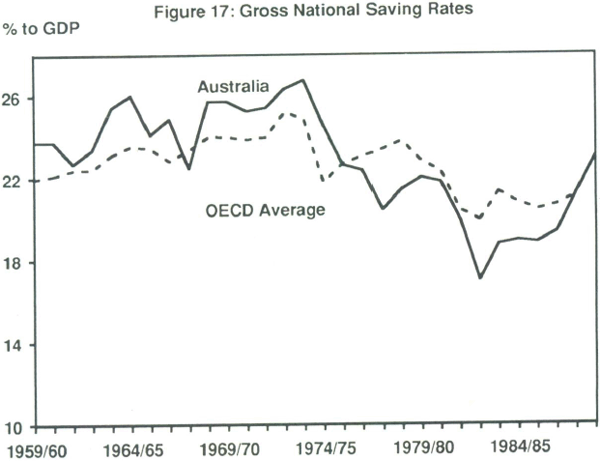
Australia's gross investment ratio has been consistently higher than the OECD average, typically by 2 to 3 percentage points of GDP (Figure 18). In the 1970s, investment ratios fell, in both Australia and for the OECD average, Australia's reduction of about 3 percentage points being slightly the larger. Subsequently however Australia's investment rates have recovered, widening the gap between Australian and overseas rates to something like the margin typical in the 1960s. The comparative data show that Australia's experience of a declining public sector contribution to aggregate investment has not been an isolated case. This seems rather to be a fairly typical response of governments under pressure for fiscal restraint, such as the United States and the U.K. Like Australia, these countries have also exhibited some tendency for private investment to expand, at least partially compensating for the reduced public sector contribution. These observations would seem to support the point made by McKibbin and Morling (1989), that the composition of the public sector balance can have an important influence on private sector behaviour.
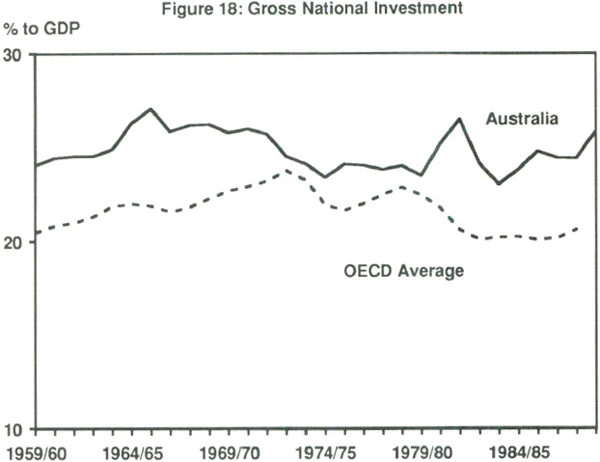
(g) Data Revisions and the Statistical Discrepancy
A regrettable feature of any study that relies on national accounts data is the degree of inherent unreliability of that data. To the extent that this problem can be quantified, it has two aspects: the existence of a large statistical discrepancy between the income and expenditure based estimates, and the potentially large revisions that can be made to published figures. It is important to be aware of both problems because on occasion they can influence the results of empirical work in identifiable ways (an example is described by Hawkins, 1979), or can influence the perceived background for policymaking (Hogan, 1979).
In a detailed statistical study of the discrepancy, McDonald and Monk (1975) reported that it was not uncommon for changes in the discrepancy to be larger than changes in GDP, this occurring in almost a third of the observations in their sample. Recent papers by Gregory (1989) and McKibbin and Morling (1989) on Australia's macroeconomic performance have noted that the interpretation of the discrepancy can have an important bearing on conclusions; this is especially so in the past four or five years, when the net movement in the discrepancy was more than 3 per cent of GDP. McKibbin and Morling argued for treating the discrepancy as unrecorded consumption, on the ground that the discrepancy and consumption were negatively correlated. Gregory was less specific but suggested the most plausible allocation would be somewhere within the private sector's net saving-investment imbalance, mainly because the public and external sector flows were likely to be more accurately measured. The importance of the discrepancy for the interpretation of consumption and savings data can be gauged from Figures 19 and 20. This paper takes the view that there is insufficient evidence as yet to justify any particular allocation of the discrepancy, but even on the extreme assumption that the discrepancy is entirely unrecorded consumption, the stability in broad terms of consumption and saving ratios does not seem to be overturned. It is important to keep in mind however that the smaller the aggregate being studied, the larger is the potential relative importance of the discrepancy for its interpretation.
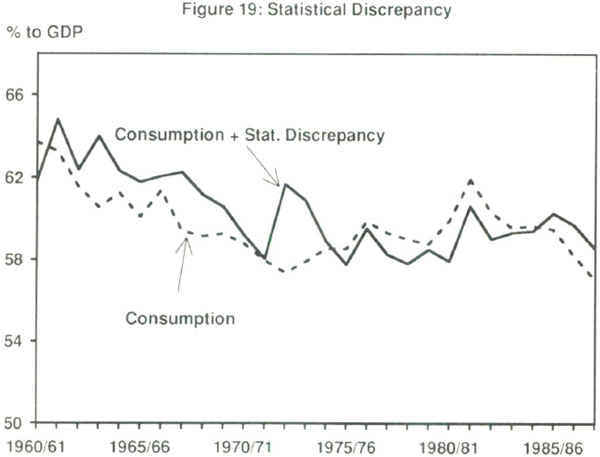
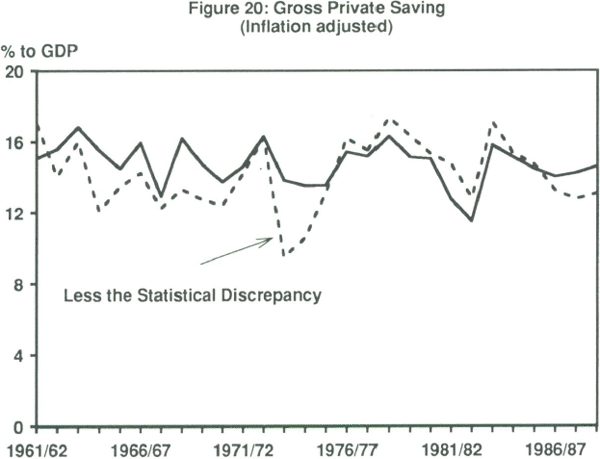
On the subject of data revisions, some commentators have focused on implications for the reported levels of GDP, F. Gruen (1979) for example noting that initial estimates tend to have a downward bias. For present purposes the main issue is whether or not revisions have a systematic effect on relativities between major variables, particularly consumption, income and investment. Some evidence on this is provided by Rossiter and Brown (1989), who confirm a positive correlation between revisions to consumption and income, thus implying that consumption and saving ratios would be less influenced by data revisions than their component parts. To gain an idea of the vulnerability to revision of the variables focused on in this paper, we conducted two simple exercises. The first was to take basic data on saving and investment ratios as available to researchers ten years ago, and compare them with the most recently revised estimates for that period. Results are shown in Figures 21 and 22. Secondly, we compared ‘first published’ with ‘latest published’ data for the same ratios over our full sample period (Figures 23 and 24).
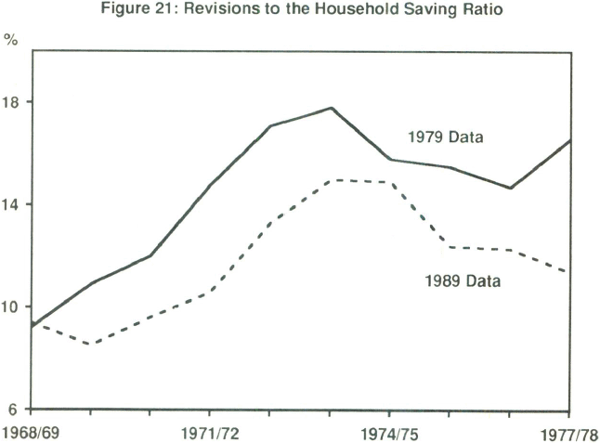
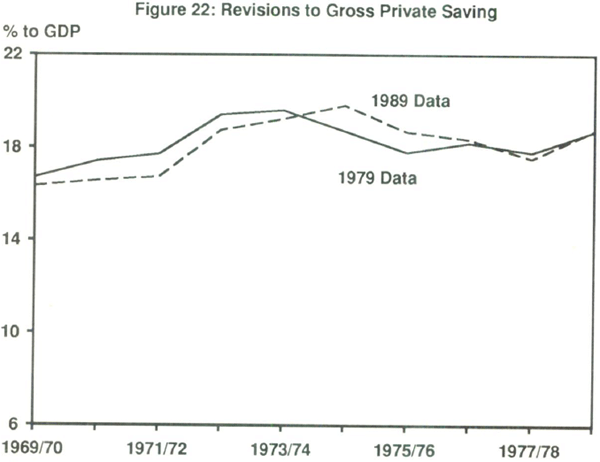
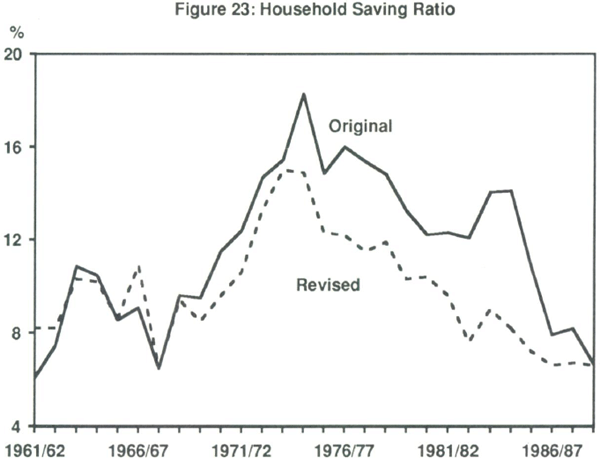
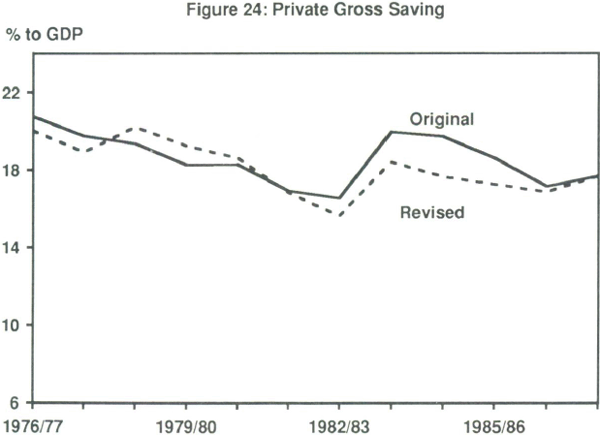
The results of the first exercise show that the gross saving ratios held up reasonably well, the ultimate revisions being quite small and not substantially altering the general picture. However the household saving ratio was subject to a quite major downward revision which removed roughly half of the rise originally reported in the early 1970s. The revision was due to a change in the method of estimating depreciation implemented in 1986, which had a substantial impact on all ‘net of depreciation’ figures, of which the household saving ratio is one example. While this revision could obviously not have been predicted, it illustrates the point that depreciation figures can be somewhat arbitrary, and that published aggregates containing a depreciation component should not be accepted uncritically. Results for the second exercise are fairly encouraging; leaving aside the depreciation problem affecting net household savings, the comparisons indicate that revisions have had almost no impact on the basic trends in gross saving, and have had only small effects on the timing of movements in this ratio.
(h) Summary
The main points raised in this essentially descriptive section were as follows:
- The widely-quoted household saving ratio has declined steadily from its peak in the mid 1970s, and now stands at a level somewhat below its historical average. There are grounds however for thinking this statistic misleading and a broader measure, gross private saving, has been much more stable. Inflation adjustment increases the apparent stability. The largest deviation from average in this measure of saving occurred in 1982/83.
- Private investment has shown evidence of a slight upward trend over the period studied. This has compensated for a trend decline in investment by the public sector which appears to have become more pronounced in the most recent years.
- National saving (the sum of savings by the private and public sectors) fell substantially in the 1970s and remained low in the 1980s, due to a major fall in the public sector component. There has been some recovery in this component in the past two or three years.
- In broad terms, this decline in saving relative to investment has corresponded to a rise in the current account deficit. This correspondence is less clear in individual years however because movements in the statistical discrepancy can be quite large relative to the current account (as for example has been the case in the most recent 5 year period).
- Australia's gross saving rates have been close to the OECD average over a long period, and declines in national saving over the past decade and a half have paralleled those in other OECD countries. At the same time, Australia's gross investment rates have generally exceeded the OECD average, and on the most recent observations the gap has been widening.
3. Influences on Private Saving
(a) Consumption Smoothing
The idea that households use savings to smooth their consumption patterns over time forms an important unifying principle in the literature on saving behaviour. Friedman's early formulation of this idea took the pragmatic approach of assuming that households consume a proportion of their permanent incomes, while avoiding placing tight theoretical restrictions on the way permanent and current incomes are related. This relationship was to be determined empirically, which was typically done by assuming permanent income, and hence consumption, are related to current income according to some distributed lag. It was then thought that additional variables such as interest rates or demographic variables could be included and the estimated parameters could be used for forecasting and policy analysis. In reviewing the performance of such models in Australia, Williams (1979) concluded that their record was poor. For forecasting purposes, they were often outperformed by simple extrapolations, and they generally underpredicted levels of household saving in the 1970s.
While poor empirical performance may have been one reason for a change of approach, a more powerful one was probably the influential critique made by Lucas (1976), who questioned the possibility that a structural consumption function existed at all. Interpreting permanent income to encompass expected future income levels, Lucas argued that the relationship between permanent and current income would change as the underlying process generating incomes changed. Thus although there is a structural relationship between consumption and permanent income, standard consumption functions are incorrect to posit a stable relationship between permanent and observed incomes. Lucas made these criticisms from the standpoint of the rational expectations paradigm, but a strict rational expectations assumption is not necessary to the argument: it merely asserts that the effect of a rise in current income on consumption is not mechanical because the response made by households will depend on the way households use information about the extent to which that rise is permanent or temporary.
The effect of the Lucas critique on the study of consumption behaviour was reinforced by the work of Hall (1978), which appeared to offer satisfactory empirical results while also avoiding the basic problem raised by Lucas. Hall's paper, and numerous subsequent studies built on the same approach, aimed to tie the idea of consumption smoothing into an explicit microeconomic framework that has directly testable implications, without having to construct proxies for permanent income. Put in fairly general terms, the approach models consumption as the outcome of a lifetime optimisation problem, in which a representative consumer maximises the expected value of some lifetime utility function subject to a lifetime budget constraint requiring the discounted value of consumption to be no greater than the discounted value of income from all sources. An implication of those assumptions is that the timing of consumption expenditures is independent of the timing of income receipts, and the testing of this implication has been central in the empirical literature.
To summarise the main principles of this type of model, Figures 25 to 27 provide a simple two-period representation. The indifference curves represent preferences for current as against future consumption, while the slope of the budget line in each case is given by the real interest rate. The points illustrated are as follows:
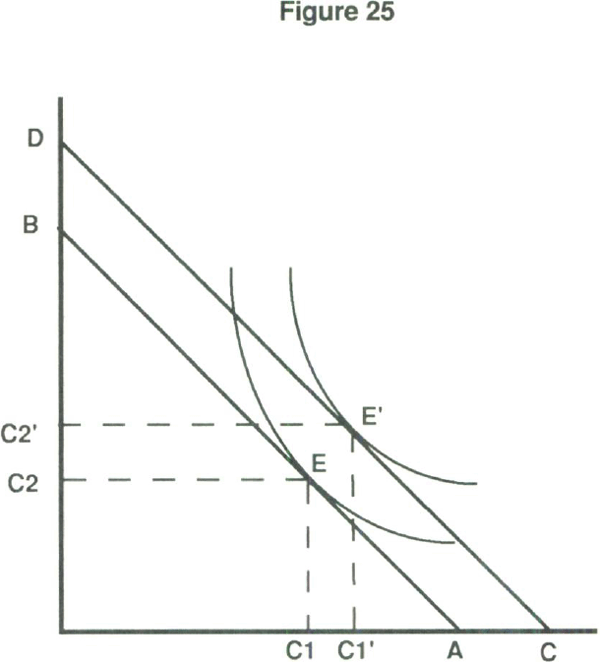
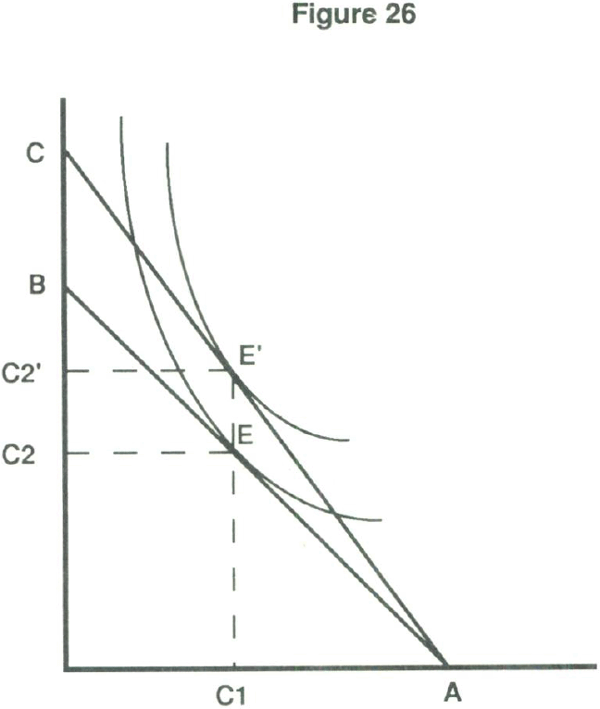
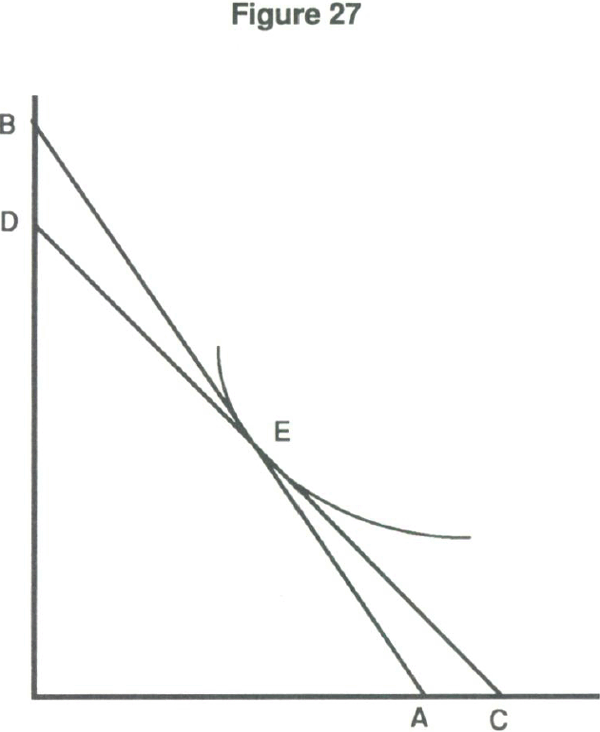
- A temporary increase in current income causes a rise in consumption which is spread between current and future periods (Figure 25). Similarly, an expected increase in future income will affect consumption in both periods.
- A rise in the interest rate, holding initial wealth constant,[10] has an ambiguous effect on current consumption because the income and substitution effects are working in opposite directions (Figure 26).
- A rise in the interest rate holding the non-interest income profile constant has an unambiguous negative effect on current consumption, provided the consumption and income profiles are sufficiently similar in the initial equilibrium (Figure 27). In terms of the diagram, point E represents the time profile of non-interest income receipts, and this point must lie on all budget constraints obtained by varying the interest rate, since it is always feasible to consume income as it accrues. If the initial optimum was also at point E, the interest rate change would represent an income-compensated change in relative prices, so that only the substitution effect would operate.[11]
The potential ambiguity of the interest rate effect causes a certain amount of confusion, but in fact a strong case can be made that the substitution effect predominates, making the theoretical effect of a rise in interest rates unambiguously negative. The reason for this is that in aggregate, the private sector receives a very small proportion of its total income in the form of net interest payments. Thus if one follows the approach of modelling aggregate consumption as being determined by a representative consumer, then in terms of the diagrams, that consumer would be in a position much more like Figure 27 than Figure 26. Developing this argument in a multi-period framework, Summers (1981) concluded that for realistic paths of labour income, the income effect of a change in interest rates is very likely to be negligible.
The paradigm of intertemporal optimisation is quite flexible and, with various modifications and extensions, describes a wide range of phenomena.[12] In this sense it is not so much a predictive theory as a modelling strategy. Adherents to the approach argue that it provides a disciplined framework for incorporating whatever additional factors are thought to be important, such as bequest motives, borrowing constraints, or tax distortions; in each case the approach requires that such features be incorporated through modifications to either the utility function or to the set of budget constraints, as opposed to what is seen as the more ad hoc procedure of directly modifying a consumption function. On the other hand, Carroll and Summers (1989) have argued that the representative consumer paradigm is itself ad hoc because of the simplifying assumptions needed to give it observable content, and because there is too much diversity between households to justify representing the aggregate as a single agent.[13] Citing data from the U.S. Consumer Expenditure Survey, they show that most saving is done by a relatively small group of high-wealth households which is not large enough to also account for the majority of consumption expenditure; in other words, the bulk of the saving and consuming are being done by different groups. Household Expenditure Survey data in Australia support a similar conclusion.
Empirical implementations of the intertemporal optimising model are typically based on variants of the following equation:
| where | ct represents consumption at t |
| rt is the after-tax real interest rate | |
| ut+1 is a forecast error representing revisions to expectations about permanent income. |
Technically this equation can be derived as a first order condition of the consumer's optimisation problem.[14] The intuitive interpretation is that the expected allocation of consumption between the current and future period depends only on the interest rate; when the real interest rate is high, current consumption is reduced relative to consumption in the future, so that expected consumption growth is increased. A testable implication of the theory is that current and lagged variables other than the interest rate do not help to predict future consumption growth, these variables being notionally incorporated in the current estimate of permanent income. This empirical framework has the important advantage that it can be tested without constructing estimates of permanent income itself.
The earliest study along these lines, by Hall (1978), assumed a constant real interest rate and thus focused mainly on the question of whether or not current income variables entered the equation significantly. Hall's results broadly supported the view that current income effects were not significant, although a current wealth effect could be detected. In a similar study of Australian data, Johnson (1983) found significant effects from current income, although it could still be claimed that consumption was close to a random walk, as Hall had originally predicted. Some of these and other early results were generally obtained by estimating the consumption equation in levels rather than differences, and were thus subject to problems of possible nonstationarity.
Subsequent studies based more closely on equation (1), and with well-defined alternative hypotheses concerning the role of current income, have generally been less favourable to the model. Two results have emerged fairly consistently. The first has been a failure to obtain significant interest elasticities; estimates by Hansen and Singleton (1983), Campbell and Mankiw (1989), Carroll and Summers (1989) and Zeldes (1989) all showed the interest elasticities to be small and insignificant.[15] Hall (1989) concluded that the elasticity of consumption with respect to the interest rate is probably zero, although Mankiw (1985) did find significant elasticities when modelling the durable and non-durable consumption components separately. A second finding that is now well supported in the empirical literature is that current income has a significant, though less than one-for-one, effect on current consumption, in contrast to the basic premise of the intertemporal optimising model. Studies by Flavin (1981), Hayashi (1982) and Campbell and Mankiw (1989) found significant current income effects, as did McKibbin and Richards (1988) in an implementation of Hayashi's approach using Australian data.
The results by Campbell and Mankiw were obtained by the fairly simple approach of augmenting equation (1) to include expected income growth as an additional explanatory variable. This was found to have a coefficient of about 0.5, leading to the interpretation that roughly half of consumption growth is related to income growth, while the remainder is determined consistently with the optimising model. These are close to the proportions estimated by McKibbin and Richards for Australia. Campbell and Mankiw concluded that consumers accounting for half of total consumption face borrowing constraints which lead them to use a rule of thumb matching consumption to current income. This inference was disputed on theoretical grounds by Zeldes (1989), who showed that the effect of borrowing constraints in an optimising framework would be to reduce average levels of consumption in all periods rather than to make consumption follow the path of current income. On this basis, the Campbell and Mankiw results could not be easily explained within an optimising framework.
The importance of consumption smoothing behaviour in Australia is illustrated in Figures 28 and 29, showing the relationship between consumption and income. In general there is a strong tendency for consumption to follow income in the long run but to partially smooth out the effects of short-run income fluctuations. The strongest example of this occurred in the 1982/83 recession, when, as was noted in Section 2(a), the private saving ratio fell to its lowest level in three decades. Consumption levels did dip slightly relative to trend in this period, but the time path of consumption remained considerably smoother than that of income.
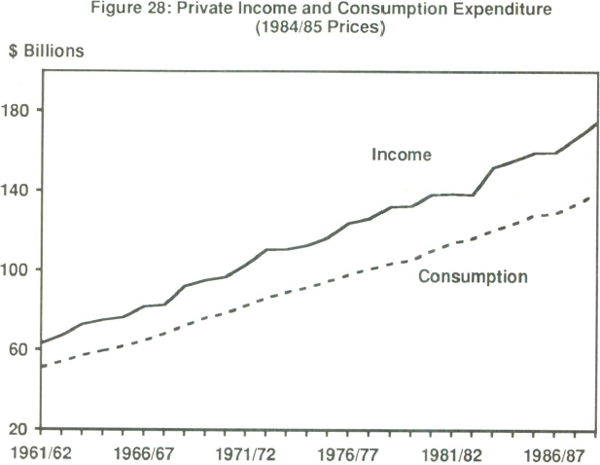
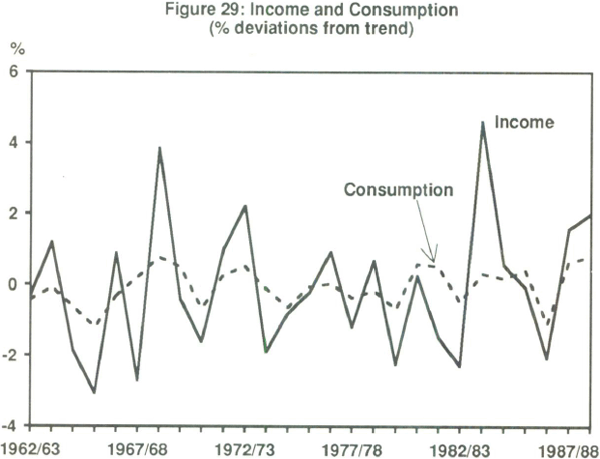
Carroll and Summers (1989) point out that the long-run tendency for income and consumption to grow in parallel is a feature common to a large number of countries. On the face of it, this behaviour is inconsistent with theories that postulate long-run or lifetime consumption smoothing, and the authors argue that the kind of test described above will fail to detect such long-run inconsistencies because they focus exclusively on short-run dynamics. The most obvious way of reconciling aggregate long-run behaviour with the hypothesis of long-run consumption smoothing would be to assert that while individual households smooth their lifetime consumption patterns, the parallel growth of income and consumption is explained by the generational replacement of households with successively higher levels of permanent income. In an attempt to provide evidence on this point, Carroll and Summers cite cross sectional data from the U.S. on consumption and income patterns by age group. The discussion that follows makes use of roughly equivalent data for Australia available from the 1984 Household Expenditure Survey. The data are summarised in Figures 30 to 35.
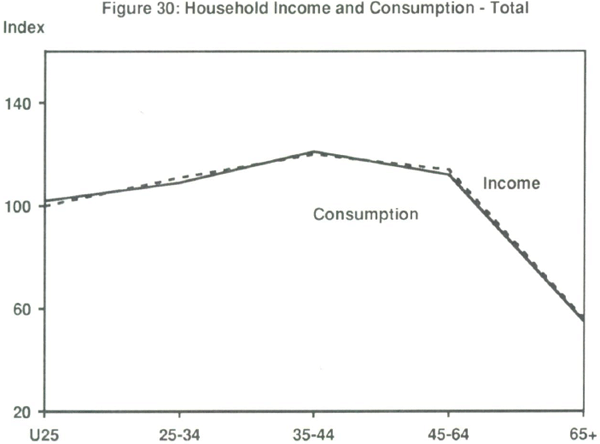
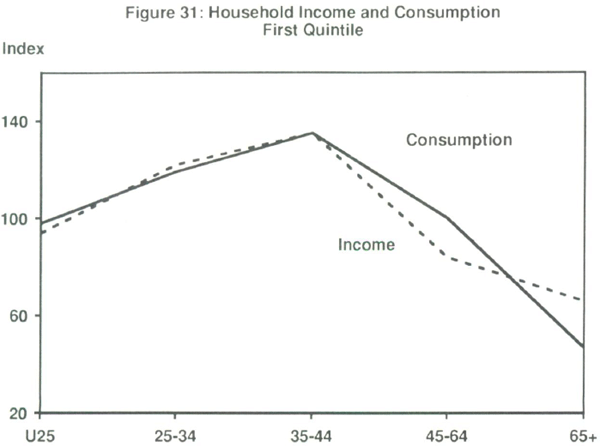
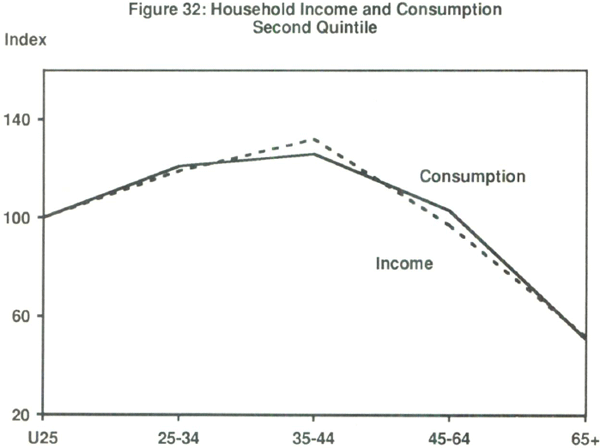
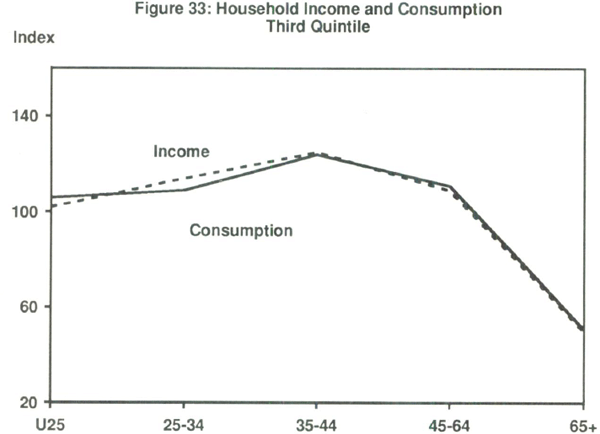
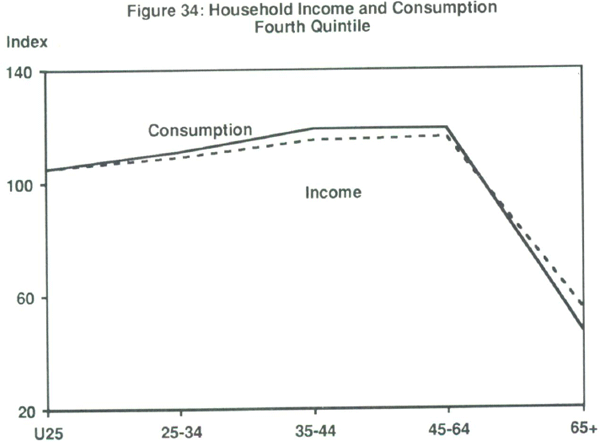
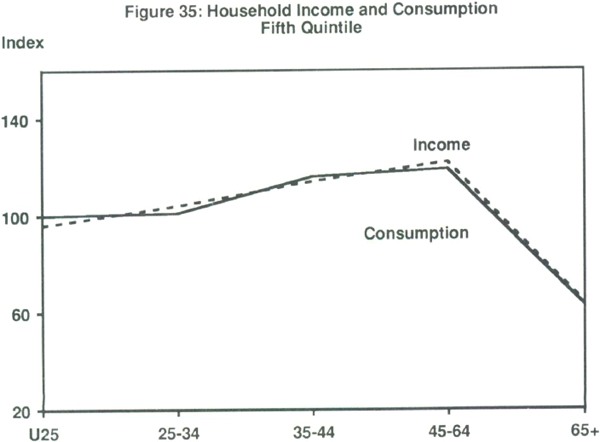
Figure 30 shows the income and consumption levels of households disaggregated by the age of the household head, with income and consumption levels measured as a ratio to the population averages. Thus for example households with head aged 35 to 44 earn 120 per cent of average income, and consume at 121 per cent of the average consumption level. The significant feature of the pattern shown is the close correlation between relative income and relative consumption levels. Households with head under 25 can expect an average growth in relative income of about 20 per cent by the time of reaching the 35 to 44 age group, and yet such households do not appear to dissave in anticipation of that income growth. While this might be explained in terms of inability to borrow against future income, behaviour at the other end of the age range cannot be accounted for in this way. After age 65, both relative income and relative consumption fall by about 50 per cent, with no apparent tendency for this to be smoothed out by saving in the preceding age groups.
The cross-sectional data are thus suggestive of behaviour in which consumption broadly follows the lifetime income pattern. On its own, this fact might conceivably be coincidental: the intertemporally optimal consumption path might happen to coincide closely with the actual time path of income. As evidence against this possibility, Figures 31 to 35 present the same information disaggregated into income quintile groups. Thus Figure 31 shows the incomes earned by the lowest quintile within each age group, expressed as a ratio to the simple average across age groups; if we assume that people remain in the same quintile group for their age-group as they age, then we can interpret the graphs as showing how households income and consumption evolve over time. What these figures suggest is that differences in the lifetime consumption patterns between groups correspond almost exactly with the associated differences in income patterns. The comparisons are not very exact of course, because households can obviously move between quintile groups during the course of a lifetime. In some cases however, allowing for this possibility exacerbates the inconsistency with lifetime consumption smoothing. For example, a household with head under 25 in the lowest income quintile within that age group, can expect income to grow by 40 per cent, even if it is assured of being in the bottom income quintile of every subsequent age group; the 40 per cent figure is therefore a lower bound on potential income growth, and the suggestion from the data is that this potential income growth is not reflected in current consumption. To take an example at the other extreme, a household in the highest quintile of the 35–44 age group can expect a massive income reduction due not only to the normal life cycle factors, but also to the possibility of moving to a lower quintile when the next age groups are reached. Yet such a household appears on average to consume close to its current income. These features of the data are similar to those reported for the U.S by Carroll and Summers and appear inconsistent with the hypothesis of lifetime consumption smoothing.
To sum up this discussion, the evidence from an examination of consumption smoothing models seems to support two main conclusions. First, there is little or no direct effect of the real interest rate on consumption spending; both income and substitution effects are small or hard to detect. Secondly, consumption smoothing behaviour appears important over relatively short periods (up to two or three years) but probably not over longer periods (decades or lifetimes). Whether this is due to borrowing constraints, short-sightedness, or ‘rule of thumb’ behaviour by consumers cannot be determined from available evidence.[16]
(b) Saving and Wealth
Data on non-human wealth compiled by Horn (1987)[17] and depicted in Figure 36 suggest that the market value of private sector wealth in Australia has risen substantially during the 1980s. From a low of 2.5 times GDP in 1982, the wealth to GDP ratio grew to 3.5 times by 1988. This increase was due almost entirely to valuation effects rather than to accumulation of assets through saving; measured at replacement value, wealth was extremely stable at about three times GDP throughout the decade.
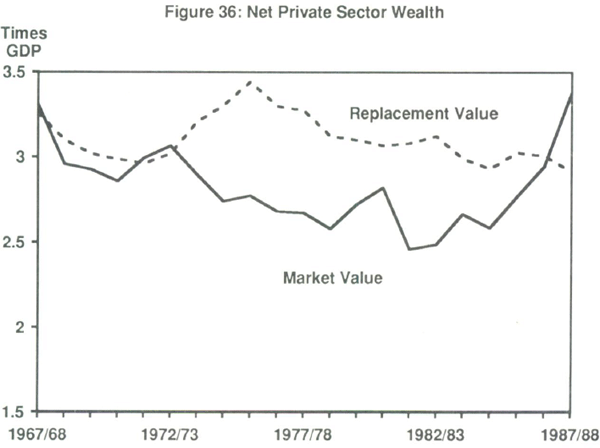
This behaviour of wealth raises a number of interesting questions about how consumers and savers respond to changing wealth levels, and how income and saving should be measured in the presence of large capital gains on the existing stock of assets. Eisner (1988) advocated the inclusion of capital gains in the national accounts as a component of income, which would have the effect of defining saving as the net increment to the market value of wealth. This may be superficially attractive, but there are strong arguments against such an approach. For one thing, capital gains differ from other forms of income because in aggregate (in a closed system) they cannot be realised and converted into consumption. Any attempt to do so would simply drive down the values of the assets concerned. The more fundamental point is that properly speaking, market valuations of wealth represent the discounted value of expected future earnings; changes in the valuation of income-earning assets should therefore be interpreted as revisions to expectations about future incomes, and not as increments to current income itself.[18]
With this interpretation in mind, wealth effects can be logically fitted into the main empirical approaches to the consumption-income relationship which have already been discussed. In the case of Friedman type permanent income models, this involves augmenting the standard distributed lag equation with a wealth term, interpreted as summarising information about future incomes not contained in the lagged income terms. This is essentially the approach taken by Simes and Horn (1986), who used the market value of wealth series referred to above and obtained a wealth coefficient of 1.9 per cent in their consumption equation.
The second empirical framework, based on the intertemporal optimising model, does not require any theoretical modification to allow for wealth effects at all. In principle, both human and non-human wealth are already incorporated in the model through the lifetime budget constraint in the form of expected net income flows; and the testing procedures favoured by proponents of this approach do not require these expected incomes to be measured. Despite this, it can be argued that the rapid growth of market-valued wealth in the 1980s raises an empirical problem for both approaches. On the one hand, the equation estimated by Simes and Horn, using data up to 1986, substantially overpredicts subsequent consumption growth. Alternatively, if one adopts the rational expectations life cycle view, the upward revisions to expected incomes implied by the wealth data should have been matched by a substantial rise in the consumption ratio, which did not in fact occur.
To calculate the increase in consumption predicted by the life cycle theory, one needs to know the proportionate increase which occurred in total wealth (both human and non-human) and hence in permanent income, information which is obviously not known with any degree of accuracy. As a rough guide, if total wealth was valued at 20 times income, then the rise in value of non-human wealth from 1982 to 1988 would have contributed about 5 per cent to the wealth-income ratio which, given a unitary elasticity of consumption, would require a rise of about 5 per cent in the consumption ratio, other things being equal.[19]
Examining a similar puzzle with respect to Japanese behaviour, Hayashi (1989) argued that the problem lay in the definition of wealth; in particular, he showed that land value is not an argument in the solution to the consumer's optimising problem.[20] The essence of his argument is that rent on land is both an income and a consumption item, so that an increase in land valuations leaves consumers with just sufficient additional imputed income from land to purchase the same land services as before, at a higher price. In other words, a rise in the real valuation of land represents an income-compensated relative price shift, rather than an increase in real income, and there is no aggregate income effect. Of course, for individual land owners an income effect does exist, but this works by redistributing wealth from renters to owners, rather than creating net wealth in the aggregate.
Hayashi's point seems theoretically sound, and it has considerable practical relevance because land revaluations have made a major contribution to apparent changes in wealth. From Figure 37 it is easy to see that Australia's private sector wealth excluding dwellings has grown much more moderately than the total; land valuation accounted for about half the rise in total wealth which occurred during the 1980s. Hayashi's theory thus makes the relative stability of the consumption ratio in the 1980s much easier to explain.
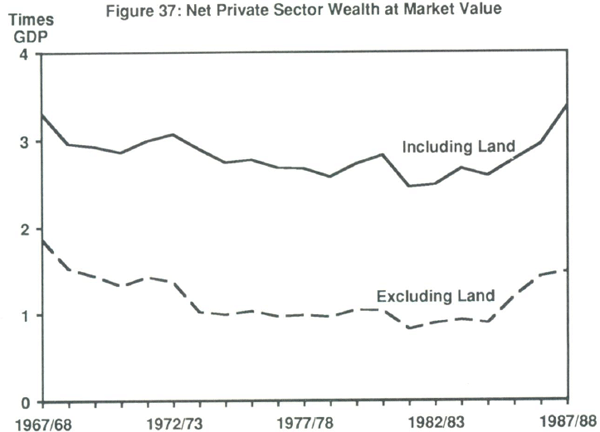
(c) Relationship Between Public and Private Saving
Models of consumption smoothing have the property that temporary shocks to disposable income are largely absorbed by changes in savings. One consequence of this property is that exogenous changes to tax rates will tend to affect public and private savings in opposite directions; thus a temporary tax cut reduces government saving, but would be largely saved by the private sector beneficiaries of the cut. As a loose short-run proposition, this would probably have wide acceptance, but proponents of the Ricardian equivalence hypothesis[21] have made the much stronger claim that an exact offset between public and private savings can be expected. The basis of this claim is that government budgets have to be balanced in the long run, so that given spending commitments, governments have discretion to vary only the timing and not the level of taxes collected. This means that tax policies can influence the timing of disposable income receipts but not their discounted present value; hence in a standard life-cycle model they would have no effect on consumption, provided the budget is seen as being balanced within the forecasting and planning horizon of taxpaying consumers.
In reviving this idea Barro (1974) anticipated what he saw as a major theoretical objection, namely that repayment of government debt does not necessarily take place within the lifetime of lenders. Barro offered the counter-argument that taxpayers with operative bequest motives would effectively have infinite planning horizons because they would take account of the expected tax liabilities of their children in determining how much to save for bequests. Not surprisingly this argument has been considered implausible by many economists, and its underlying assumptions have been hotly debated. Bernheim (1989) attacked the idea of making intergenerational transfers central to the model on the ground that it led to absurd conclusions; specifically, one could prove by a seemingly innocuous extension of Barro's assumptions that all government actions are neutral. Other authors have similarly focused on the implausibility of Barro's assumptions about intergenerational transfers, but this issue seems something of a diversion. The main point is simply to determine whether planning horizons are long enough that individuals would adjust their behaviour to take account of the distant actions of governments. D. Gruen (1988) and Cochrane (1989) both suggested that the information requirements for this to happen are most unlikely to be met by actual consumers; moreover, the efficiency gains to be had from using such information to fine tune the timing of consumption expenditures are probably small. Carmichael (1982) discussed the conditions under which Barro's debt neutrality proposition would hold, and concluded that the extent to which private savings offset the behaviour of the government could only be determined empirically.
Recent reviews of the empirical literature by Bernheim (1989) and by Leiderman and Blejer (1988) have not uncovered any consensus on the subject. Barro himself does not find this surprising because there is a serious econometric identification problem involved. Both public and private savings tend to move cyclically, rising in booms and falling in recessions, and in order to determine the effect of public sector deficits on private saving, the exogenous component of the public sector position must first be extracted. Due to the difficulty in doing this, Barro (1989, p. 49) prefers to rely on results which ‘ … exploit situations that look more like natural experiments’. Pursuing this line he cites some evidence from Israel, where large swings in budget deficits have occurred, and a study by Carroll and Summers (1987) on the U.S. and Canadian economies. Both experiences were interpreted as being favourable to the Ricardian equivalence proposition.
Recent experience in Australia also comes close to being a natural experiment for this purpose, but here the results do not seem favourable. Between 1985/86 and 1988/89, the public sector deficit was reduced by 5 per cent of GDP, and public saving was dramatically increased from 1.1 to 6.6 per cent of GDP. The Ricardian approach would suggest that the private sector reduce its saving roughly one for one with the change in public sector saving, but clearly this did not occur; private saving fell only 1.2 percentage points over the period. Further evidence is provided by the longer term evolution of fiscal policy. As was noted in Section 2, private saving ratios were quite stable throughout the 1960s, 1970s and 1980s despite the major swings in public savings after the mid 1970s. Such behaviour suggests very little tendency for private savings to offset changes in the position of the public sector. This has the important policy implication that public saving can be used as an instrument to influence saving at a national level.
One example should be mentioned of a case (similar to examples noted by Kotlikoff (1984)) where something like Ricardian equivalence does seem plausible. The 1987/88 Commonwealth Budget announced a tax measure which imposed a 15 per cent tax on concessional superannuation contributions, with an offsetting reduction in the tax on the accumulated final benefit. This had the effect of raising about $1 billion annually in additional revenue, which would count as an increment to public savings. It can be plausibly argued that fund contributors would not adjust consumption levels to reflect their reduced current after tax incomes, since both their final benefits and current liquidity are unaffected by the change in timing of tax liabilities. Thus private saving would adjust so as to offset exactly the fiscal effect of the current tax increase.
(d) Demographic Influences
Changes in population growth can be thought to influence saving and investment behaviour in two main ways. First, an increase in population creates a demand for additional capital stock to house and to employ the extra population. Modelling the capital requirements of a growing population, Blanchard (1983) concluded that an increase in population growth will tend to contribute to higher current account deficits because the additional population will generate more investment than saving. Secondly, changes in population growth generally coincide with changes in age composition, and to the extent that saving patterns differ across age groups, this will influence aggregate saving levels. Details of Australia's population and age structure, including ABS projections out to the year 2031, are provided in Table 7.[22]
| Age Composition (per cent) |
Growth Rate of Total Population (average to year shown) |
|||
|---|---|---|---|---|
| 0–14 | 15–64 | 65 and Over | % | |
| 1960 | 30.2 | 61.3 | 8.5 | |
| 1965 | 29.5 | 62.0 | 8.4 | 1.6 |
| 1970 | 28.8 | 62.8 | 8.4 | 2.0 |
| 1975 | 27.4 | 63.9 | 8.7 | 1.8 |
| 1980 | 25.3 | 65.1 | 9.6 | 1.2 |
| 1985 | 23.6 | 66.2 | 10.2 | 1.5 |
| 1989 | 22.3 | 66.6 | 11.0 | 1.7 |
| 1996 | 21.5 | 66.7 | 11.9 | 1.5 |
| 2011 | 19.1 | 67.9 | 13.1 | 1.2 |
| 2021 | 18.1 | 65.9 | 16.0 | 1.0 |
| 2031 | 17.6 | 63.6 | 18.9 | 0.8 |
Like a number of other countries, Australia currently has an ageing population structure, and this is expected to continue for several decades, primarily as a result of continuation of the low birth rates of the 1970s and 1980s. According to the most conservative ABS projections, the proportion of the population over age 65 will rise from 11 per cent in 1989 to about 19 per cent by the year 2031. At the same time, the young dependency ratio (persons under 15) is expected to fall, as to a lesser extent is the proportion accounted for by the remaining group, the working age population. Under the normal presumption that the over 65 population are heavy dissavers, these projections would imply a declining level of private saving in the out-years of the projection, preceded at some point by a build up in private savings in preparation for that. On the basis of the projections it would seem not unreasonable to expect the savings build up to have begun already, since the working age population ratio is already close to its projected peak. The fact that this has not happened is consistent with the cross sectional data discussed earlier, which indicated very little variation in saving rates across age groups. The implication is that on average, households expect to reduce consumption after retirement rather than to undergo significant dissaving; if such behaviour is maintained, the changing age composition will not have a major impact on aggregate private saving levels.[23]
Arguably one of the major reasons why saving rates vary so little in the years around retirement is to be found in the system of retirement benefit payments. A further discussion of this and related topics will be given in Section 3(e), where it will be argued that the effective tax structure created by these benefits provides a strong incentive for households to match consumption more closely to income than would otherwise be the case. For the moment it is important to note that this effectively shifts a large part of the burden of providing for an ageing population from the private to the public sector, although of course policies to encourage private retirement provisions may well prove effective in reversing this. Some idea of the orders of magnitude involved can be gauged by considering the current budgetary cost of pension benefits in relation to the size of the retirement-aged population. Budget estimates for 1989/90 put the cost of age pensions at $8.5 billion, or about 2.5 per cent of GDP. The projected 80 per cent increase in the share of the pension-aged population during the next 40 years could therefore be expected to increase this cost to almost 5 per cent of GDP, assuming the relative value of pensions is maintained. Offsetting this to some extent, there would be some possibility for reduction in the cost of child benefits arising from the trend reduction in the young dependency ratio.
While these changes are not insignificant it is easy to overstate their importance. Compositional changes in the population take place very slowly and their effects may easily be overshadowed by other variables with more immediate impacts. A common finding in overseas studies using simulations of age-specific saving rates[24] is that they have tended to overestimate the effect of demographic changes on aggregate savings when simulated within history. This is not to deny that differences in demographic characteristics may be important in explaining broad differences in saving behaviour between countries. Dean et al. (1989) ranked a cross section of countries by demographic factors thought to influence saving and found that this ranking conformed closely with a ranking of countries by actual saving rates.
A further demographic characteristic which might be thought to have influenced saving behaviour is the tendency for average household sizes to fall, possibly leading to increased expenditure on the housing stock. According to Household Expenditure Survey data, the average number of persons per household fell from 3.1 in 1974/75 to 2.8 in 1984, a fall of 10 per cent. Although perhaps significant for other reasons, the effect on saving through investment in housing seems likely to be quite small: a reasonable upper limit would be to assume this effect has added 10 per cent to dwelling expenditure, which would amount to only about half a per cent of GDP, much smaller than the normal cyclical variation in dwelling investment. Allowance should then be made for two offsetting factors: a likely tendency for smaller households to have smaller incomes and require smaller dwellings; and possible reductions in other consumption expenditures when faced with higher per capita housing costs.
(e) Effects of the Tax and Benefit System
It was suggested in Section 3(a) that aggregate saving is not very sensitive to changes in interest rates. This might be taken to imply that saving behaviour would be insensitive to tax measures affecting after-tax real rates of return, but there are two reasons why such a conclusion does not necessarily follow. First, taxation may have important effects on the allocation of saving without affecting its level; even if there were no substitutability at all between current and future consumption, it is likely there would still be substitution between assets on the basis of differing after-tax rates of return. Secondly, theory suggests that permanent or long-term changes in after-tax interest rates have a much larger effect on aggregate saving than do temporary changes.[25] It is the latter which will tend to be picked up (if at all) in evidence from time series data, whereas the relevant features of the tax system are likely to be in place on a much more permanent basis. Effects of taxation on aggregate saving could thus be large but hard to quantify. This section discusses aspects of the tax and benefit system which might have important effects on the allocation and level of private savings. Other aspects of taxation relevant to investment are discussed in Section 4(b).
In discussing possible distortions in the tax system it is necessary to begin with a view as to what constitutes a neutral system. All taxes are theoretically distortionary (apart from lump sum transfers) and there are two main candidates as benchmarks for neutrality in a weaker sense: a comprehensive income tax, under which real incomes from all assets are taxed at equal rates; and an expenditure tax. In the policy debate there is a certain amount of naive advocacy of the second, on the presumption that it would boost saving by penalising current consumption. This is not strictly correct, since an expenditure tax would be taxing both current and future spending; rather, the effect on saving would operate indirectly by allowing a reduction in marginal tax rates on income from assets. A number of researchers (for example, Summers (1984) and Hall and Rabushka (1985)) have suggested that an expenditure tax would result in higher savings than would be the case under a comprehensive income tax system, but it seems unlikely that a fully expenditure based system with zero income taxes would ever be implemented. For the purposes of this paper it suffices to note that both kinds of tax system require non-discrimination in the taxation of incomes from different assets.
As set out in Table 1, the main vehicles for household saving in Australia are dwellings, nominal interest-bearing assets, and superannuation contributions. The tax treatments of returns on these assets vary markedly. Imputed returns on owner-occupied housing, including capital gains, are untaxed. Nominal interest-bearing assets on the other hand are extremely heavily taxed in real terms, due to the inclusion of the inflation premium in taxable income; examples with real effective tax rates in excess of 100 per cent are not difficult to construct. (This issue is discussed in more detail by Carmichael at this conference.) The case of superannuation fund earnings is more complex. Prior to changes introduced in the 1983/84 Budget the treatment of superannuation was extremely concessionary; employer contributions were fully deductible, fund earnings were untaxed, and final benefits could be taken as a lump sum taxed at 5 per cent. The 1983 changes raised this tax rate to 30 per cent while maintaining a threshold under which lump sums could be taxed at the more concessional rate of 15 per cent. Changes announced in the 1988 May Statement essentially preserved these features but brought forward the timing of tax payments by introducing a 15 per cent tax on employer contributions and fund earnings, with offsetting reductions to the tax on final benefits.[26] The net effect of these provisions is that saving through superannuation is considerably less favourably treated than before 1983, but is still favourable relative to the alternative of direct holdings of the assets of superannuation funds by households. The concession is higher for higher marginal rate taxpayers.
Looking at the data in Table 1 there can be little doubt that concessional treatment of superannuation earnings has led to a shift in the allocation of savings in that direction. What is more difficult to determine is whether or not this has increased saving in aggregate. The answer depends on the extent to which superannuation assets are substitutable for other stores of saving. This question has recently been addressed by Stemp (1988), who cites a number of overseas studies confirming that tax concessions for pension schemes have added to aggregate saving, although by much less than the gross increase in contributions. However, in Australia's case there has been no obvious tendency for private savings to increase over the past decade, despite the fact that life and super contributions increased as a ratio to GDP by over 4 percentage points. This being the case, and taking into account the cost to public revenue of the superannuation tax concessions (recently estimated by Treasury at about $3 billion), it is possible the net effect on national saving may actually have been negative, although of course the counterfactual case is not known.
A possible explanation for the lack of response of aggregate private saving to the increase in superannuation contributions may lie in a consideration of the income distribution of contributors. Based on data from the 1984 Household Expenditure Survey, contributions were provided disproportionately by high income earners, the highest income quintile providing 45 per cent of fund contributions, and the top two quintiles together providing 75 per cent. The significance of this is that high income earners may be less likely than others to be constrained by liquidity, and therefore better able to treat superannuation as a substitute for other assets.[27] On this reasoning the spread of superannuation to lower income earners may well contribute to an increase in aggregate saving in the future. It may be noted in passing that there are no obvious allocational inefficiencies associated with any general tendency for saving through superannuation to increase. As has been noted by EPAC (1988), superannuation funds are an intermediate vehicle for savings flows and should not add to distortions in the final allocation of savings except to the extent that they face different tax incentives to those applying to investors generally. In this respect the case of superannuation differs from that of housing, where favourable tax treatment implies a direct distortion in the final allocation of savings. The incentive to over-invest in housing may however be mitigated by a low elasticity of demand for housing. Tax policy and housing investment is discussed further by Britten-Jones and McKibbin (1989).
A related, and potentially very important, consideration is the role of publicly funded pension benefits in affecting the incentive to save for retirement. As was noted in section 3.1, it is a striking feature of the cross sectional data on consumption and incomes by age group that spending in the years around retirement so closely follows the pattern of income. Freebairn, Porter and Walsh (1989), among others, have argued that the incentive to save for retirement in Australia is significantly reduced by the age pension system, citing the high proportion of the pension aged population receiving benefits and the high effective marginal tax rates applying in the range of incomes in which pension benefits are shaded out. A recent statement by the Minister for Social Security (1989) put the number of people receiving age pension benefits at 1.7 million, about 75 per cent of the pension-aged population. Further details of the importance of pension benefits in the total incomes of this group are provided in Table 8 below.
| 1 | 2 | 3 | 4 | 5 | Total | |
|---|---|---|---|---|---|---|
| Average Weekly Household Income ($) | 87.92 | 124.62 | 164.72 | 219.97 | 551.72 | 229.48 |
| Proportion of income from government benefits (%) | 95.60 | 82.40 | 87.30 | 62.20 | 14.40 | 47.5 |
| Av. no. of persons per household | 1.004 | 1.33 | 1.84 | 1.99 | 2.43 | 1.72 |
| Proportion of households in group which own house outright (%) | 68.10 | 77.20 | 78.60 | 81.00 | 82.90 | 77.50 |
| Source: Household Expenditure Survey, 1984. (ABS 6530.0) | ||||||
These figures suggest that a substantial majority (at least 80 per cent) of households have income and spending patterns in the years around retirement which enable them to qualify for benefits, to the extent of forming a majority of their post-retirement income. Stemp (1988) notes the possible adverse consequences of this for labour force participation, particularly when combined with the possibilities for taking concessionally taxed lump sum superannuation benefits as a means of financing earlier retirement. Figure 38 confirms that there has been a dramatic decline in labour force participation for age groups around the retiring age, though this has stabilised and been partially reversed since the mid 1980s. Broadly speaking, the decline in participation by these groups seems to have coincided with a progressive liberalisation of access to age pensions, and increases in their real value.[28]
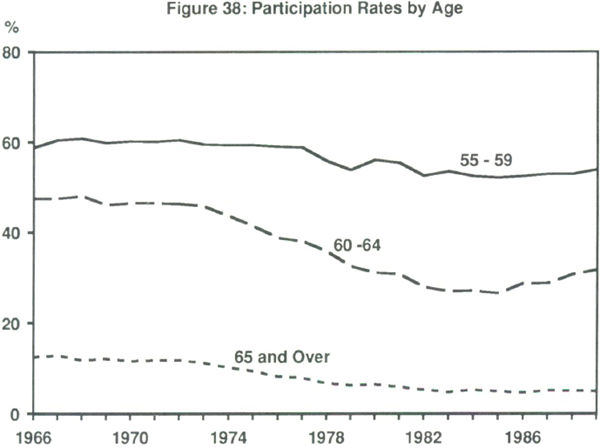
The question arises as to what is the likely effect of these incentives on aggregate saving levels. A definitive answer obviously cannot be given, but the answer may not be as clearly negative as it would at first seem. Incentives to rely on income-tested government pensions would certainly be expected to reduce saving in the years prior to retirement, but they would also largely eliminate the dissaving phase that would otherwise be expected to follow retirement. The net effect on private saving will be negative only to the extent that average household wealth remaining at end of life is expected to be reduced; and although certain theoretical arguments are available to support such an effect, it hardly seems likely to be large. On the other hand, there is a potentially large effect on government sector balances arising from the provision of pension benefits. Presumably this would have to be offset at some stage (possibly contemporaneously) by taxation, making the pension scheme implicitly self-financing. Such a solution in the longer term would mean higher marginal tax rates, and even if there were no direct effect on aggregate saving rates would probably, as Stemp suggested, have adverse consequences for labour force participation.
4. Saving and Investment
The discussion in Section 3 considered a variety of aspects of the partial equilibrium relationship between saving and income. Equilibrium for the economy as a whole requires that aggregate saving be equal to aggregate investment, either continuously (in a closed economy), or in some long-run sense (in an economy with access to international capital markets). An understanding of the determinants of saving thus requires an understanding of the way saving and investment interact. This section discusses issues relevant to this interaction but does not aim for a comprehensive treatment, because of the considerable overlap with the paper by Tease on the Balance of Payments in this volume. Section 4(a) reviews evidence on the determinants of business investment behaviour, and Section 4(b) discusses explanations for the observed relationship between investment and saving.
(a) Demand for Investment Goods
In principle, characterisations of the investment demand function can be classified into two groups: those which attempt to model investment as a process of adjustment toward some optimally determined capital stock, and those which model the investment flows directly in terms of their presumed short-run determinants. In practice the distinction between these two approaches has not been particularly clear cut. Stock oriented approaches, generally based on neoclassical foundations, have proved inadequate in explaining investment behaviour without building in adjustment lags and various other ad hoc features which bring them much closer to approaches based on direct flow modelling. Nonetheless, a consideration of the long-run predictions of neoclassical investment theory will provide a useful starting point for an examination of the Australian data.
The simplest neoclassical models of demand for the factors of production are completely analogous to demand systems in consumer theory. In the absence of adjustment costs, optimising firms can choose their factor demands independently in each period, and combinations of labour and capital are chosen so as to minimise production costs for any given level of output. The main prediction of such a model is that the degree of capital intensity is an increasing function of the rental price of labour relative to that of capital. For practical purposes, this should be regarded as a long run prediction, since adjustment lags will clearly be of considerable importance.
To compare the qualitative predictions of theory with experience, Figures 39 to 41 show a measure of capital intensity, the capital/output ratio at constant prices, and measures of real factor costs: the cost of labour is measured by the real wage relative to trend productivity, and variation in the cost of capital is represented by movements in the real interest rate[29] (a depreciation rate would have to be added to obtain an estimate of the real level of capital costs). Commenting on the trends in these variables, Carmichael and Dews (1987) noted that changes in capital intensity appeared broadly consistent with the qualitative predictions of the model, with capital intensity tending to rise especially after upward shocks to real wages. It is noteworthy however that capital accumulation seems to have been quite unresponsive to the major changes in real interest rates which took place during the period. In particular the shift from real interest rates close to zero in the 1960s, to the high real interest rates of the 1980s, represents a massive proportionate change in the cost of capital. This may suggest a low elasticity of substitution between factors, but there are other pieces of evidence which conflict with this conclusion. Carmichael and Dews find empirical support for an aggregate Cobb-Douglas production function, implying unitary elasticity of factor substitution, when testing against the more general alternative of a CES function. Russell and Tease (1988) provide evidence for a sizeable real wage effect on aggregate employment, although their equation does not incorporate direct measures of the cost of capital. A further piece of evidence to consider is the relative stability of the profit share of national income. This implies that actual rates of profit earned have been much more stable than the rates of return offered in debt and equity markets. Arguably, the real empirical problem here is to explain why returns in these markets have been able to be out of line with returns in the real economy, rather than to explain why the real economy did not adjust to be consistent with the rates of return offered in debt and equity markets.
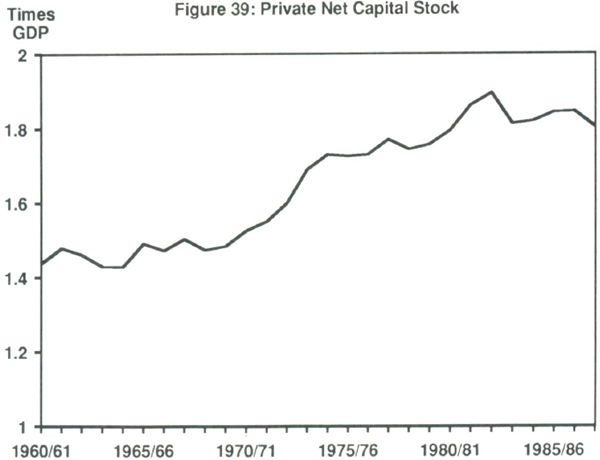
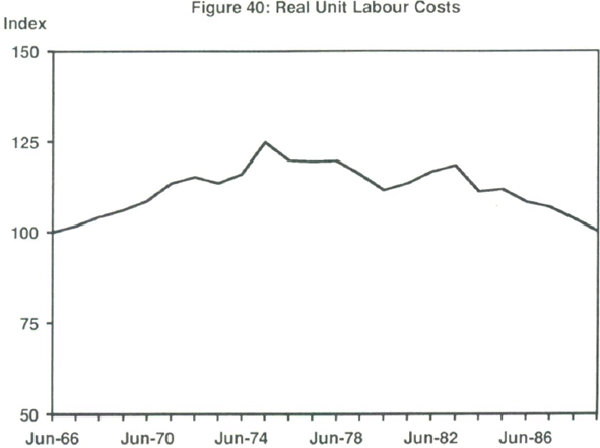
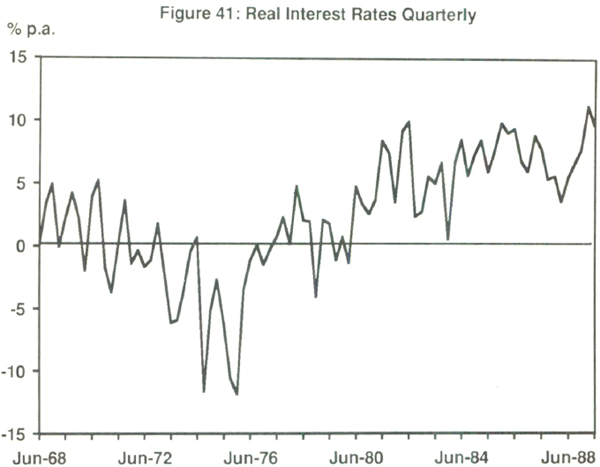
In any case, given the relatively slow rates of adjustment of the capital stock and the difficulty in lining up capital stock data with long-run equilibrium conditions, it is fairly clear that explanations of investment need to focus primarily on short-run factors. A popular starting point is the ‘q theory’, which asserts that investment is positively related to the ratio of the market price of capital to its replacement cost. This can be derived as an extension to the simple neoclassical model with capital adjustment costs, and it follows that the q theory gives the same long-run predictions while potentially explaining temporary deviations in the capital stock from steady state values. Estimates of the q ratio for Australia have been provided by Dews (1988), and are depicted along with data on business investment expenditures in Figure 42. The lagged q ratio does go some way towards explaining the broad trends in investment, particularly the decline during the 1970s. In this respect it is consistent with the conceptually similar measure of the incentive to invest calculated by EPAC (1986), defined as the ratio of expected profitability to the cost of debt finance. Abstracting from the resources boom, the pick up in investment in the second half of the 1980s also seems to match reasonably well the behaviour of the q ratio, although the lag from the rise in q to the recovery of investment was quite long.
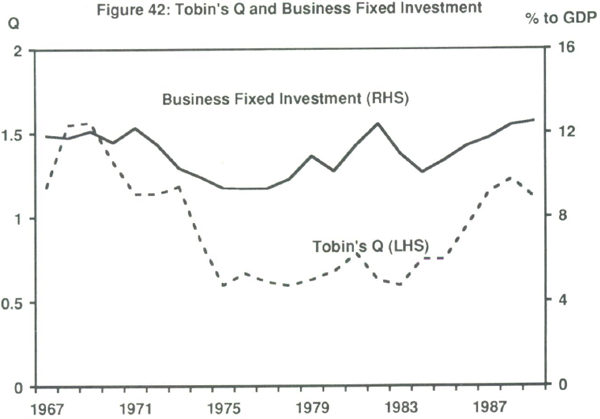
Econometric implementation of the q theory by McKibbin and Siegloff (1987) succeeded in demonstrating a significant role for q, but showed that the q theory on its own does not provide a satisfactory explanation for investment behaviour; explanatory power is considerably enhanced by introducing the level of profits as an explanatory variable. The authors also used an own-lag on investment in their equation, thus indicating that the capital stock adjustment costs incorporated in the q theory need to be supplemented by a second order adjustment process on investment itself. McKibbin and Siegloff reported extremely good within-sample fit for their equation, and a significant role for the q variable, but the approach highlights the difficulty of interpreting results once it is recognised that additional factors outside the optimising framework need to be incorporated. For example, movements in q over time are quite closely correlated with company profits, so a q theory may be difficult to distinguish empirically from a ‘rule of thumb’ theory in which firms invest out of retained earnings. Also, the use of an output variable to proxy profitability gives their equation some of the characteristics of the accelerator approach, for which support had been found by Stegman (1982) and in earlier studies reviewed by Hawkins (1979).
Relationships between business investment, profits, and output are illustrated in Figures 43 and 44. These show fairly clearly the empirical regularities identified in the econometric studies. In particular, both of the major downward shocks to the profit share, in 1974/75 and 1982/83, were associated with falls in business investment of similar magnitude, and the upward trend in profits through the middle and late 1980s was matched by rising investment. This of course says nothing about how the profit share itself is determined. Chapman's discussion (1990) puts strong emphasis on the role of wages in influencing profits, and argues that wage setting institutions have had an important influence on factor shares, and hence on investment.
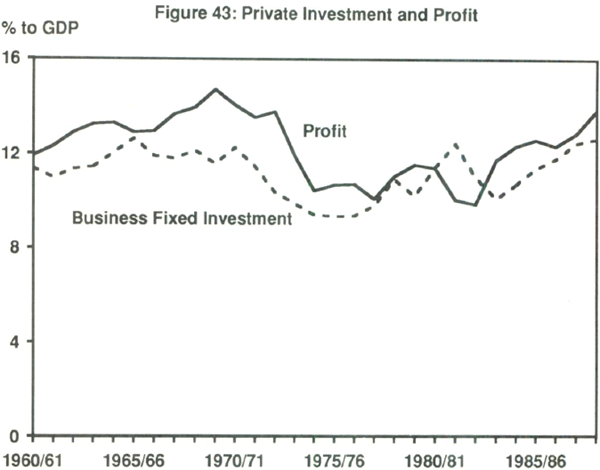
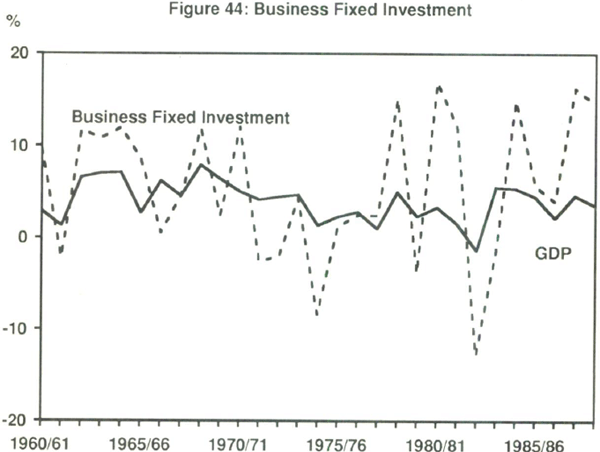
The relationship between investment growth and output growth should obviously not be regarded as causal, unless it could be established that one variable clearly leads the other. In fact the relationship seems mostly simultaneous, although some tendency for investment to lag seems apparent in the early 1980s. With investment expenditure having a much larger coefficient of variation than GDP, the investment ratio tends to move procyclically; that is, in the same direction as the private saving ratio.
(b) How Are Saving and Investment Related?
The stylised facts concerning private saving and investment ratios, as outlined in Section 2, were that inflation-adjusted private saving rates have remained relatively stable, while private investment has shown a modest upward trend relative to income. In the short term, both saving and investment are correlated with the cycle in income, but investment has almost always exceeded saving, implying a current account deficit, and this gap has increased somewhat in the 1980s over the levels typical of the 1960s and 1970s. Given the long-run constraint that accumulated investment is financed by accumulated savings (assuming unstable behaviour is ruled out), this raises the question as to how saving and investment are related in the short to medium term, and what sorts of factors could be appealed to in explaining the tendency for saving to fall short of investment.
One approach to these questions, pioneered by Feldstein and Horioka (1980) and applied to Australian data by Tease, focuses on short-term correlations between saving and investment ratios. Feldstein and Horioka argue that by definition, this correlation in a closed economy is equal to one, while in an open economy the two variables could be expected to be independently determined. They therefore interpret the saving-investment correlation coefficient as a measure of capital mobility, and find evidence in a number of countries that capital mobility in this sense has been increasing. Other studies, for example Dean et al. (1989), have confirmed this tendency, as has Tease for the case of Australia. Nonetheless these studies generally find that correlations between saving and investment remain quite high (usually around one half) even in the most recent sub-periods when there would appear to be no important regulatory impediments to capital mobility. This should not be considered surprising, for two reasons. First, the saving and investment functions are likely to be influenced by shocks to variables which influence both, most notably income. Secondly, it is possible that deficits have a direct influence on private sector behaviour for a variety of reasons such as credit rationing. If so, the supply of domestic saving will place some degree of constraint on investment behaviour independently of constraints on international capital mobility.
Results of the Feldstein-Horioka type may be useful in describing short-run behaviour, but they are unlikely to take us very far in understanding any persistent tendency for investment to exceed saving, which is fundamentally a problem of intertemporal equilibrium. A useful framework for considering this problem is the model of saving-investment equilibrium used recently by Blanchard (1983) in a study of Brazilian current account deficits.[30] The model economy operates so as to maximise
with respect to the per capita consumption path, subject to the accumulation equations
| where | Ct = total consumption |
| Lt = population (assumed to grow exogenously) | |
| Bt = stock of external liabilities | |
| Kt = capital stock | |
| ψ = capital stock adjustment cost function | |
| θ = world real interest rate | |
| F = production function | |
| It = investment | |
| δ = rate of depreciation | |
| ' indicates a time rate of change. |
The solution to this model implies the following steady state properties:
where Y is output, k* is the optimal capital-output ratio and n is the steady state growth rate of the population. The first two of these conditions imply that per capita levels of debt and physical capital are constant in the steady state. The third condition shows the relationship between population growth and aggregate investment: an increase in population growth increases the investment-output ratio by a factor given by the optimal ratio of capital to output. A typical capital-output ratio of about 2 would imply that each 1 per cent increase in the population growth rate increases the investment-output ratio by 2 percentage points.
The above framework has the advantage of being consistent both with permanent income consumption models, and with a q theory of investment, and it imposes long-run consistency between consumption and investment plans. This means imposing the long-run constraint that accumulated investment expenditures must be financed by the accumulation of savings, and ensures that in the steady state the current account is in balance. A limitation is that this is a one-good model, and therefore abstracts from issues of resource allocation between industries. Essentially the current account deficit or surplus depends only on the relativity between current and permanent incomes, which in turn depends on the level of capital accumulation relative to the steady state. Blanchard shows that for plausible parameterisations and starting values, the model can replicate the broad features of a variety of country experiences.
In the context of such a model, a medium-term tendency toward current account deficits could be given two kinds of explanation. The first is based on undercapitalisation. Broadly speaking, a country whose capital stock is low relative to population will have a high marginal capital productivity and will tend to be a capital importer. Undercapitalisation in this sense will occur when a country has a higher than average rate of population growth, or in developing countries which start from an extremely low capital base. As an example of the latter, Hayashi (1989) has argued that the high rates of saving and investment in Japan in the post-war period can be attributed to an initial undercapitalisation relative to the United States economy. Undercapitalisation due to a higher-than-average population growth will also induce high rates of investment. However, there is no reason to expect population growth to induce increased saving. The resultant gap between saving and investment therefore implies a larger account deficit.
A second type of explanation for a persistent saving-investment gap is based on distortions to microeconomic incentives, due in particular to the tax structure. Here the argument is essentially the same as before, but instead of the deficit representing a natural transition to the optimal capital stock, it is assumed that the tax system encourages a bringing forward of consumption or investment spending relative to the optimum.
Both of these potential explanations have a certain amount of appeal in Australia's case. The undercapitalisation hypothesis is plausible because of Australia's high population growth relative to that of comparable developed countries, and because there has been a steady increase during the past 30 years in the proportion of the population of working age (see Table 8). Between 1960 and 1989 the working age population rose from 61 to 66 per cent of the total (close to its projected peak), almost certainly implying an increase in the demand for capital relative to the population as a whole. This effect would have been reinforced by a trend increase in the labour force participation rate. Consistent with these observations, Carmichael and Dews (1987) note that the rate of investment per person in Australia has generally exceeded the OECD average. Parmenter and Peter (1990) provide support for the operation of an undercapitalisation effect arising in the specific case of a population increase due to immigration.
Although these considerations give plausibility to the undercapitalisation hypothesis as an explanation for external deficits, the hypothesis is inherently difficult to substantiate because it refers to undercapitalisation relative to some normal level of capital intensity in comparable countries, and presumably the norm is changing as technology changes. Comparisons between countries are in any case difficult to make because of differences in the mix of industries, which presumably have differing capital requirements. F. Gruen (1986) however argues that the post-war decline in Australia's international ranking in terms of per capita income, is prima facie evidence of a relative decline in capital intensity.
Tax distortions also seem a plausible contributing factor to the saving-investment gap. In addition to those aspects of the tax and benefit system relevant to private saving, discussed in Section 3(e), it has been argued by a number of researchers that there are important distortions on the investment side. Studies by Macfarlane (1989) and by EPAC (1989) have considered the implications of the interaction between inflation and taxation, as did an earlier study by Carmichael and Stebbing (1983). The main point raised by Macfarlane concerned the tax deductibility of nominal interest costs which, for a given real interest rate, tends to increase the incentive to invest and reduce the incentive to save as inflation rises. The EPAC study focused on the question of whether or not this feature of the tax system would lead companies to prefer debt over equity finance, and concluded that following the introduction of dividend imputation, the tax system has been roughly neutral in its impact on the financing decision; this however has no direct bearing on the aggregate investment decision or on the size of corporate and household deficits, and does not negate the point that nominal interest deductibility reduces effective interest rates when inflation is high. A related distortion arises from the asymmetric tax treatment of nominal interest and capital gains, the latter being taxed only in real terms. This treatment would imply an increasing incentive to invest in nominally appreciating assets (including physical capital) as inflation rises, although obviously not to the same extent as would have been the case when capital gains were largely tax free. The quarantining provisions on negative gearing, operating between July 1985 and July 1987, represented a partial attempt to offset this distortion as it related to investment in buildings.
In assessing the net effect of these and other tax distortions, it is important to recognise that distortions are present to some degree in all economies. If all countries operated a tax system which penalised saving and subsidised investment, the theoretical net effect would be to drive up the pre-tax real rate of interest to the point consistent with saving-investment equilibrium, with no net effect on capital flows. The critical question is therefore whether or not the domestic and external tax systems interact in such a way as to provide a net incentive for the Australian private sector to import capital. This question cannot be fully answered without a detailed international comparison of tax systems. However, in at least one case, namely the tax treatment of nominal interest, the direction of the net effect seems to be unambiguously toward capital importing. The reason for this is that the size of the penalty on savers, and the subsidy to investors, depends in each country on the local inflation rate; thus the net effect is in the direction of encouraging capital flows from low inflation to high inflation economies.[31] The size of this implicit subsidy on external borrowing would be equal to the inflation differential times the relevant tax rate, which would amount in Australia's case to a subsidy of about 2 percentage points on the interest rate. Whether this is large enough to have a noticeable influence on behaviour is another question.
In summary, both population growth and tax distortions potentially offer plausible explanations for the medium-term tendency for investment to exceed saving in Australia. At this stage, evidence as to their relative contributions is not available, and this should be considered an important topic for further study, since the policy implications of the two hypotheses are very different. A further point to note is that neither explanation provides an obvious reason why deficits should have increased in the 1980s. In particular the biases arising from the tax system have probably been reduced during the decade. In this regard it would be necessary to appeal to some further factor such as financial deregulation, which may have enabled the private sector to take greater advantage of existing incentives to finance investment out of borrowings.
5. Conclusions
It is widely believed that during the 1980s Australia has developed a serious problem of under-saving. This belief appears to be based on movements in the conventionally quoted household saving ratio, which has been in steady decline since the mid 1970s. This paper has argued that the impression given by the household saving ratio is misleading, for three reasons. First, the distinction between the household and corporate sectors is to some extent artificial, and much of the decline in household saving has been offset by increased savings in the corporate sector. Secondly, household saving is usually quoted in net of depreciation terms, but the depreciation estimates are unreliable and highly sensitive to assumptions used in their construction. Thirdly, the official statistics on saving do not take into account the effects of inflation on the real value of nominal balances. Failure to allow for this effect generally results in an overstatement of private saving and an understatement of public saving, and this measurement bias has produced a spurious peak in recorded private savings in the mid 1970s.
Broadening the focus to consider gross savings of the private sector as a whole, and adjusting for the inflation transfer, it becomes apparent that private saving rates have been quite stable throughout the past three decades. Thus at least on the simplistic criterion of comparison with past standards, Australia does not seem to have developed any problem of under-saving during the 1980s. A slightly less comforting picture emerges however when international comparisons are made; these show that although Australia's private saving rates have generally been around the levels typical of other OECD countries (with the exception of Japan), Australia has tended to fall toward the lower end of that range. On this basis a weak case could be made for the under-saving hypothesis, but it would remain true that this is greatly overstated by the decline in the household saving ratio.
In reviewing explanations for the behaviour of private saving and consumption, a number of reasonably solid conclusions have emerged. The short-term movements in the saving ratio appear to be qualitatively well explained by simple principles of consumption smoothing, causing the saving ratio to move inversely with income. However, both the time series and cross sectional data suggest that consumption follows income much more closely over longer periods than is predicted by standard versions of the life-cycle theory. It is likely that the explanation for this must include a combination of factors including rule of thumb behaviour by households, borrowing constraints interacting with uncertain future income, and disincentives to saving for retirement arising from the system of publicly funded pensions. Other factors thought to be important, such as movements in interest rates, and changes in the value of wealth, appear to have little or no effect on short-run saving behaviour on the basis of the evidence reviewed here.
Aggregate investment by the private sector has shown a certain amount of cyclical variation in the 1980s but on average has been as strong as in previous decades and has been consistently higher as a ratio to GDP than the OECD average. The investment ratio has also been on an upward trend through the decade. The most important determining factor in the short run appears to be profitability, but as a long-run proposition at least part of the strong investment performance is probably due to Australia's relatively high population growth. The extent to which population growth can explain the persistent gap between investment and saving is an important unresolved issue.
Distortions in the tax and benefit system form the main additional source of explanation for Australia's persistent private sector deficits. Two main features seem biased against saving; the tax treatment of nominal interest, and the age pension benefit system. The latter provides a strong incentive to match consumption to income in the years around the retiring age. The tendency for participation rates in those age groups to decline suggests that this is being achieved at least partly by earning less, rather than by spending more, a tendency which could well become a major issue as it interacts with the projected ageing of the population structure during the next forty years. The tax treatment of nominal interest represents a distortion on both the saving and investment sides tending to increase the attractiveness of investment, and to reduce the incentive to save when inflation is high. On the investment side, this effect is reinforced by the asymmetric treatment of interest costs and capital gains.
The net effect of these and other distortions on saving and investment is not known, partly because it depends on complex interactions with similar distortions in other countries. What is clear however is that there are significant non-neutralities in Australia's tax system, and the paper has argued that their likely net effect is in the direction of encouraging the net importing of capital. One important reason for this is that the distortions arise in part from interactions of the tax system with inflation, and will therefore tend to be more serious in countries with relatively high inflation rates.
A final issue of policy relevance which should be highlighted concerns the public sector contribution to national saving and investment levels. A major goal of fiscal policy in the second half of the 1980s has been to reduce public sector deficits, a goal which has been dramatically achieved with the shift into surplus by 1988/89. Without wishing to minimise the importance of this achievement, it is often overlooked that fiscal balance has been restored at much lower levels of public investment than were typical prior to the mid 1970s. The cumulative effect of reduced public capital formation is a neglected area of study in Australia. Presumably there is some degree of substitutability between public and private investment spending, and indeed this may have been a contributing factor in the expansion of business investment ratios through the 1980s. However, to the extent that these expenditures are not close substitutes, the decline in the relative provision of public sector capital may have a detrimental long-term effect on aggregate productivity.
Footnotes
Reserve Bank of Australia. [*]
A data appendix describing the sources of data, and various calculations used in the paper, is provided in Research Discussion Paper 9004, Reserve Bank of Australia. [1]
Some weak evidence to the contrary is provided by Poterba (1989). [2]
Calculations are set out in the data appendix to Research Discussion Paper 9004, Reserve Bank of Australia. In principle, private sector debts to the foreign sector should also be inflation adjusted, but here the issues are more complex because the size of the adjustment depends on the mix of currencies in which those debts are denominated. Estimates presented in the appendix suggest that adjustments affecting the external sector are relatively small because the denomination of debts is heavily weighted toward low inflation currencies. However, ommission of the external sector adjustment means that private savings are conservatively estimated when foreign debt is high. Nevile (1989) has recently calculated public sector inflation adjustments which are similar to those presented here. [3]
Hayashi (1989) has recently estimated a depreciation rate of 9.8 per cent in Japan. [4]
Imported computer prices have been falling steadily throughout the 1980s. Excluding computers, prices of imported capital goods fell by 10 per cent in the year to March 1989. [5]
This assumes unidentified flows are included in the net figure. [6]
The exact application of such funds is unclear because of the presence of large unidentified flows, which may represent further unidentified external asset acquisition. [7]
Public sector figures used in this paper are on a national accounts basis, and may therefore differ slightly from those given in Commonwealth Budget papers. [8]
We have not attempted to calculate inflation-adjusted figures for these comparisons, but any adjustment would tend to lower private savings rates and correspondingly raise the savings of the public sector. For most countries the adjustment would be largest in the 1970s when OECD inflation rates were highest. [9]
Initial wealth is defined as the maximum feasible level of current consumption (achieved by cutting future consumption to zero). Initial wealth will be invariant to the interest rate if there is no non-interest income in the second period. [10]
This point is made by Blanchard and Fischer, 1989. [11]
See for example King (1985). [12]
Deaton (1986) provides a detailed analysis of such issues. [13]
A set of sufficient conditions for this linearisation to be exact is that utility is time additively separable and iseolastic, and forecast errors are log normally distributed. A derivation of the equation under these conditions is provided by Hansen and Singleton (1983). The equation can also be considered as a linear approximation for a much wider variety of cases. [14]
Estimation of equation (1) for Australia over the period 1968(3) to 1989(4) yielded the result: σ =.05, s.e.(σ) = .08, where s is the elasticity of substitution. This is similar to the results obtained in overseas studies. [15]
Shefrin and Thaler (1988) propose an interesting ‘two-self’ model in which consumers operate according to various rules of thumb. They argue that such a model can explain many of the empirical anomalies. Other discussions of rule of thumb behaviour are provided by Cochrane (1989) and D. Gruen (1988). [16]
Subsequently updated by Horn to June 1988. [17]
To adopt the latter approach would involve double counting; if expected income in some future period was revised upward, the additional income would be counted both in the period when the revision is made, and again when the extra income is earned. [18]
Blanchard (1985) shows that for log utility functions the life cycle model reduces to a simple rule which makes consumption proportionate to wealth. Approximate solutions for the more general case are derived by Campbell and Mankiw (1989). [19]
This argument strictly applies only to land used for housing. [20]
So described because Ricardo (1951) first canvassed the idea, though he did not think
it realistic. Referring to the choice between debt and tax financing of expenditures,
he wrote (p. 186)
‘In point of economy, there is no real difference in either of the modes;
[they] are precisely of the same value; but the people who pay the taxes
never so estimate them, and therefore do not manage their private affairs
accordingly.
‘It would be difficult to convince a man … that a perpetual payment
of £50 per annum was equally burdensome with a single tax of £1,000.
He would have some vague notion that the £50 would be paid by posterity,
and would not be paid by him; but if leaves his fortune to his son, and leaves
it charged with this perpetual tax, where is the difference whether he leaves
him £20,000 with the tax, or £19,000 without it? This argument
of charging posterity with the interest of our debt, or of relieving them
from a portion of such interest, is often used by otherwise well informed
people, but we confess we see no weight in it.’
[21]
The ABS projections offer several scenarios. The one presented here is the high birth rate, high immigration scenario, which results in the most conservative estimates of population ageing. (Source: ABS [1988]) [22]
This conclusion was supported in a recent EPAC paper (1988) which made similar use of the 1984 Household Expenditure Survey information. [23]
Examples include Auerbach and Kotlikoff (1987, 1989), and Wiseman (1989). Studies by Modigliani, Feldstein and Horioka were reviewed by Heller (1989). [24]
Barro (1985) provides an exposition of this result. [25]
Details are obtained from 1983/84 Commonwealth Budget Paper No. 1, and Treasury Economic Statement, May 1988. [26]
King and Dicks-Mireaux (1982) provide empirical support for this proposition. [27]
These changes are reviewed by F. Gruen (1985) who notes that the process of liberalisation began to be reversed after 1978/79 with various steps to tighten eligibility criteria. [28]
After-tax real rates are discussed by Carmichael (this volume). [29]
Blanchard and Fischer (1989) discuss similar models, and show that results obtained using the representative agent assumption such as described here can be replicated under assumptions of atomistic competition. [30]
Inflation induced tax distortions are discussed further by Carmichael (this volume). [31]
References
Anstie, R.K., Gray, M.R. and Pagan, A.R. (1983) ‘Inflation and the Consumption Ratio’, The Effects of Inflation Theoretical Issues and Australian Evidence, pp. 321–361, Centre for Economic Policy Research, Australian National University, Canberra.
Aschauer, D.A. (1989a), ‘Is Public Expenditure Productive?’, Journal of Monetary Economics, 23, pp. 177–200.
Aschauer, D.A. (1989b), ‘Does Public Capital Crowd Out Private Capital?’, Journal of Monetary Economics, 24, pp. 171–181.
Auerbach, A.J. and Kotlikoff, L.J. (1987), Dynamic Fiscal Policy, Cambridge University Press: Cambridge, USA.
Auerbach, A.J. and Kotlikoff, L.J. (1989) ‘Demographics, Fiscal Policy and U.S. Saving in the 1980s and Beyond’, NBER Working Paper No. 3150.
Australian Bureau of Statistics (1988), ‘Projection of the Populations of Australia, States and Territories 1987 to 2031’, Catalogue No. 3222.0.
Barro, R.J. (1974), ‘Are Government Bonds Net Wealth?’, Journal of Political Economy, 82, pp. 1095–1117.
Barro, R.J.(1984), Macroeconomics, John Wiley & Sons, New York.
Barro, R.J. (1989a), ‘A Cross-Country Study of Growth, Saving and Government’, NBER Working Paper No. 2855.
Barro, R.J. (1989b), ‘The Ricardian Approach to Budget Deficits’, The Journal of Economic Perspectives, 3(2) Spring, pp. 37–54.
Bascand, G.M.(1989), ‘Implications of Alternative Tax Bases: with particular Reference to Direct and Indirect Consumption Taxes’, in Head, J.G. (ed.), Australian Tax Reform in Retrospect and Prospect, Australian Tax Research Foundation, Sydney.
Bernheim, B.D. (1989), ‘A Neoclassical Perspective on Budget Deficits’, Journal of Economic Perspectives, 3(2) Spring, pp. 55–72.
Bladen-Hovell, R. and Richards, G.M.(1983), ‘Inflation and Australian Savings Behaviour’, 1959–1981, Australian Economic Papers, 22, pp. 290–301.
Blanchard, O.J. (1983), ‘Debt and the Current Account Deficit in Brazil’, in Armella, P.S., Dornbusch, R. and Obstfeld, M. (eds.), Financial Policies and the World Capital Market: The Problem of Latin American Countries, University of Chicago Press, Chicago.
Blanchard, O.J. (1985), ‘Debts, Deficits and Finite Horizons’, Journal of Political Economy, 93(2), pp. 1583–1591.
Blanchard, O.J. and Fischer, S. (1989), Lectures on Macroeconomics, MIT Press, Cambridge, Massachusetts.
Britten-Jones, M. and McKibbin, W.J. (1989), ‘Tax Policy and Housing Investment in Australia’, Reserve Bank of Australia Research Discussion Paper 8907.
Campbell, J.Y. and Mankiw, N. G. (1989), ‘Consumption, Income and Interest Rates: Reinterpreting the Time Series Evidence’, NBER Working Paper No. 2924.
Carmichael, J. (1982), ‘On Barro's Theorem of Debt Neutrality; The Irrelevance of Net Wealth’ American Economic Review, 72(1), pp. 202–213.
Carmichael, J and Dews, N. (1987), ‘The Role and Consequences of Investment in Recent Australian Economic Growth’, Reserve Bank of Australia Research Discussion Paper 8704.
Carmichael, J. and Plowman, K. (1985), ‘Income Provision in Old Age’, Australian Economic Review, 3rd Quarter, pp. 130–144.
Carmichael, J. and Stebbing, P.W. (1983), ‘Some Macroeconomic Implications of the Interaction Between Inflation and Taxation’, in Pagan, A.R. and Trivedi, P.K. (eds.), The Effects of Inflation: Theoretical Issues and Australian Evidence, pp. 101–136.
Carroll, C. and Summers, L.H. (1987), ‘Why Have Private Saving Rates in the United States and Canada Diverged?’, Journal of Monetary Economics, 20, pp. 249–279.
Carroll, C. and Summers, L.H. (1989) ‘Consumption Growth Parallels Income Growth: Some New Evidence’, NBER Working Paper No. 3090.
Chapman, B. (1990), ‘The Labour Market’, this volume.
Cochrane, J.H.(1989) ‘The Sensitivity of Tests of the Intertemporal Allocation of Consumption to Near-Rational Alternatives’, American Economic Review, pp. 319–337.
Corden, W.M. (1979), ‘A Summary’ in Norton, W.E. (ed.), Conference in Applied Economic Research, Reserve Bank of Australia.
Dean, A., Durand, M., Fallon, J. and Hoeller, P. (1989), ‘Savings Trends and Behaviour in OECD Countries’, OECD Department of Economics and Statistics Working Papers, No. 67.
Deaton, A.S. (1986), ‘Life Cycle Models of Consumption: Is the Evidence Consistent with the Theory?’, NBER Working Paper No. 1910.
Dews, N. (1988), ‘The Cost of Capital: Some Issues’, Reserve Bank of Australia Research Discussion Paper 8807.
Eisner, R. (1988), ‘Extended Accounts for National Income and Product’, Journal of Economic Literature, 26, pp. 1611–1684.
Eisner, R. (1989), ‘Divergencies of Measurement and Theory and Some Implications for Economic Policy’, American Economic Review, 79 (1), pp. 1–13.
EPAC (1986), ‘Business Investment and the Capital Stock’, EPAC Council Paper No. 10.
EPAC (1988), ‘Trends in Private Saving’, EPAC Council Paper No. 36.
EPAC (1989), ‘Trends in Corporate Debt’, EPAC Council Paper No. 41.
Feldstein, M. and Horioka, C. (1980), ‘Domestic Saving and International Capital Flows’, Economic Journal, 90, pp. 314–329.
Flavin, M.A. (1981), ‘The Adjustment of Consumption to Changing Expectations About Future Income’, Journal of Political Economy, 89(5) pp. 974–1009.
Freebairn, J., Porter, M. and Walsh, C. (eds) (1989), Savings and Productivity: Incentives for the 1990s, Allen and Urwin, Sydney.
Gregory, R.G. (1989), ‘The Current Account and Australian Economic Policy under the Labor Government’. Paper prepared for 18th Pacific Trade and Development Conference, December 11–14, 1989, Kualer Lumpur, Malaysia.
Gruen, D.W.R. (1988), ‘Ignorance and Ricardian Equivalence (or Keynesians of the World Unite, You Have Nothing to Lose but Your Bonds)’, Australian National University Working Paper No. 165, July 1988.
Gruen, F.H. (1979) ‘Statistician's Revisions of Non-Farm Product Estimates’, Australian Economic Papers, 18, December, pp. 397–400.
Gruen, F.H. (1985), ‘Australian Government Policy on Retirement Incomes’, Economic Record, September, pp. 613–621.
Gruen, F.H. (1986), ‘How Bad is Australia's Economic Performance and Why?’, Economic Record, 62, (177), 180–193.
Hall, R.E. (1978), ‘Stochastic Implications of the Life Cycle – Permanent Income Hypothesis: Theory and Evidence’, Journal of Political Economy, 86, pp. 971–987.
Hall, R.E. (1989), ‘Consumption’ in Barro, R. (ed.), Modern Business Cycle Theory, Basil Blackwell: Oxford, U.K., pp. 153–177.
Hall, R.E. and Rabushka, A. (1985), The Flat Tax. Hoover Institution Press, Stanford.
Hansen, L.P. and Singleton, K.J. (1983), ‘Stochastic Consumption, Risk Aversion, and the Temporal Behaviour of Asset Returns’, Journal of Political Economy, 91(2), pp. 249–265.
Hawkins, R.G. (1979), ‘Business Fixed Investment in the 1970s’ in Norton, W.E. (ed.), Conference in Applied Economic Research, Reserve Bank of Australia, pp. 193–231.
Hayashi, F. (1982), ‘The Permanent Income Hypothesis: Estimation and Testing by Instrumental Variables’, Journal of Political Economy, 90(5), pp. 895–916.
Hayashi, F. (1986), ‘Why is Japan's Saving Rate So Apparently High?, NBER Macroeconomics Annual 1986’, The MIT Press: Cambridge, Massachusetts, pp. 147–234.
Hayashi, F. (1989), ‘Is Japan's Saving Rate High?’, Federal Reserve Bank of Minneapolis Quarterly Review, Spring, pp. 3–9.
Heijdra, B.J. and James, S.O. (1989), ‘Ricardian Equivalence: Some Australian Evidence’, University of Tasmania Discussion Paper 1989–04.
Heller, P.S. (1989), ‘Aging, Savings and Pensions in the Group of Seven Countries: 1989–2025’, IMF Fiscal Affair Department, Unpublished manuscript, January 31.
Hogan, W.P. (1979), ‘Quicksands of Policy-Making’, Australian Economic Papers, December, pp. 384–396.
Horn, P. (1987), ‘Private Non-Human Wealth of Australia Residents in the NIF88 Model’, Background Paper No. 9.
Johnson, P. (1983), ‘Life-Cycle Consumption Under Rational Expectations: Some Australian Evidence’, The Economic Record, 59(167), pp. 345–350.
King, M.A. (1985), ‘The Economics of Saving: A Survey of Recent Contributions’ in Arrow, K.J. and Honkapohja, S (eds.), Frontiers of Economics, Basil Blackwell: Oxford, U.K. pp. 227–295.
King, M.A. and Dicks-Mireaux, L.D.L. (1982), ‘Asset Holdings and the Life-Cycle’ Economic Journal, 92, pp. 247–267.
Kohli, U.R. and Ryan, C.J. (1985), ‘Neoclassicial Theory and Australian Business Investment: A Reappraisal’, Reserve Bank of Australia Research Discussion Paper 8501.
Kotlikoff, L.J. (1984), ‘Taxation and Savings: A Neoclassical Perspective’, Journal of Economic Literature 22, pp. 1576–1629.
Lattimore, R. (1989), ‘Capital Formation in Australian Manufacturing, 1954–55 to 1987–88’, Bureau of Industry Economics, Canberra, Working Paper 54.
Leiderman, L. and Blejer, M.I. (1988), ‘Modelling and Testing Ricardian Equivalence: A Survey’, IMF Staff Papers, 35(1), pp. 1–35.
Lucas, Robert, E.J. (1976), ‘Econometric Policy Evaluation: A Critique’, Carnegie-Rochester Conference Series, 1, pp. 19–46.
Macfarlane, I.J. (1989), ‘Money, Credit and the Demand for Debt’, Reserve Bank of Australia Bulletin, May, pp. 21–31.
Mankiw, N.G. (1985), ‘Consumer Durables and the Real Interest Rate’, The Review of Economics and Statistics, 67(3), pp. 353–362.
McDonald, J. and Monk, P. (1975), ‘An Analysis of the Statistical Discrepancy in the Australian Quarterly National Accounts’, Australian Journal of Statistics, 17(3), pp. 148–160.
McKibbin, W.J. and Morling, S.R. (1989), ‘Macroeconomic Policy in Australia: A Longer Run Perspective’. Paper prepared for the Conference on ‘Australian Economic Policy’, 27–28 November.
McKibbin, W.J. and Richards, A.J. (1988), ‘Consumption and Permanent Income: The Australian Case’, Reserve Bank of Australia Research Discussion Paper 8808.
McKibbin, W.J. and Siegloff, E.S. (1987), ‘A Note on Aggregate Investment in Australia’, Reserve Bank of Australia Research Discussion Paper 8709.
Minister for Social Security (1989), ‘Better Incomes: Retirement Income Policy Into the Next Century’, A Statement by the Honourable Brian Howe, MP Minister for Social Security, August.
Nevile, J.W. (1989), ‘Structural Deficits and Fiscal Policy Stance in Australia 1966–67 to 1988–89’, The University of New South Wales, Centre for Applied Economic Research, Working Paper No. M-7.
Ouliaris, S. (1981), ‘Household Saving and the Rate of Interest’, The Economic Record, September, pp. 205–214.
Parmenter, B.R. and Peter, M.W. (1990), ‘Two Papers on the Economics of Immigration’, Melbourne University Institute of Applied Economic and Social Research Working Paper No. 3–90.
Piggott, J. (1986), ‘The Nation's Wealth – Some New Calculations for Australia’, Reserve Bank of Australia Research Discussion Paper 8606, June.
Podger, A.S. (1986), ‘The Economies of Superannuation’, Australian Economic Review, 3, pp. 75–86.
Poterba, J.M. (1989), ‘Dividends, Capital Gains and the Corporate Veil: Evidence from Britain, Canada and the United States.’ NBER Working Paper No. 2975.
Reserve Bank of Australia (1989), Financial Flow Estimates, Bulletin, November.
Ricardo, D. (1951), ‘Pamphlets and Papers 1815–1823’, in Sraffa, P.,(ed.), The Works and Correspondence of David Ricardo, IV, Cambridge University Press: Cambridge, U.K.
Rossiter, P. and Brown, N. (1989), ‘The Analysis and Modelling of Revisions to the Australian National Accounts: Some Preliminary Results’. A Paper presented to the Economic Society of Australia Annual Conference, University of Adelaide, July 10–13.
Russell, B. and Tease, W. (1988), ‘Employment, Output and Real Wages’, Reserve Bank of Australia Research Discussion Paper 8806.
Shefrin, H.M. and Thaler, R.H. (1988), ‘The Behavioural Life-Cycle Hypothesis’, Economic Inquiry, 26(4), pp. 609–643.
Shiller, R.J. (1982), ‘Consumption, Asset Markets and Macroeconomic Fluctuations’, Carnegie-Rochester Conference Series on Public Policy, 17, Autumn, pp. 203–238.
Simes, R.M. and Horn, P.M. (1986), ‘Wealth, Inflation and the Consumption Function’, paper presented to the 15th Conference of Economists, Monash University, August.
Stegman, T.R. (1982), ‘Estimation of an Accelerator-Type Investment Function with a Profitability Constraint, by the Technique of Switching Regressions’, Australian Economic Papers, 12, pp. 379–391.
Stemp, P.J. (1988), ‘Tax Concessions for Occupational Superannuation: Implications for Aggregate Saving’, Australian National University, Centre for Economic Policy Research Discussion Paper No. 185, January.
Summers, L.H. (1981), ‘Capital Taxation and Accumulation in a Life Cycle Growth Model’, American Economic Review, 71, pp. 533–544.
Summers, L.H. (1984), ‘The After-Tax Rate of Return Affects Private Savings’, American Economic Review, 74(2), pp. 249–253.
Walters, R. and Dippelsman, R. (1985), ‘Estimates of Depreciation and Capital Stock, Australia’, Occasional Papers, Australian Bureau of Statistics.
Wilcox, D.W. (1989), ‘Social Security Benefits, Consumption Expenditure and the Life Cycle Hypothesis’, Journal of Political Economy, 97(2), pp. 288–304.
Williams, R.A. (1979), ‘Household Saving and Consumption’, in Norton, W.E. (ed.), Conference in Applied Economic Research, Reserve Bank of Australia, pp. 129–192.
Wiseman, A.C. (1989), ‘Projected Long-Term Demographic Trends and Aggregate Personal Saving in the United States’, Journal of Post Keynesian Economics, pp. 497–508.
Zeldes, S.P. (1989), ‘Consumption and Liquidity Constraints: An Empirical Investigation’, Journal of Political Economy, 97(2), pp. 305–346.



